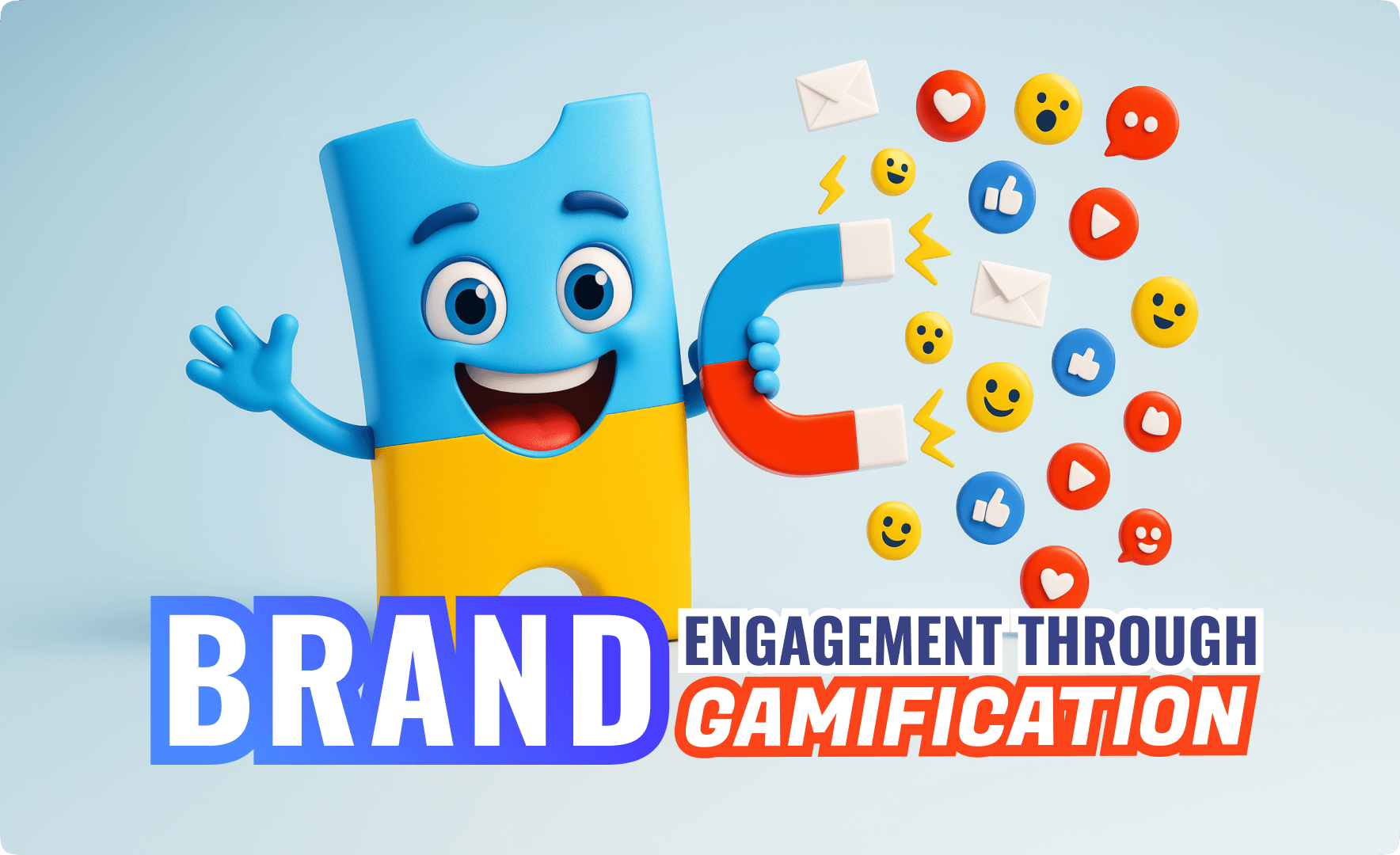MarTech Tool Stack to Promote Your Business
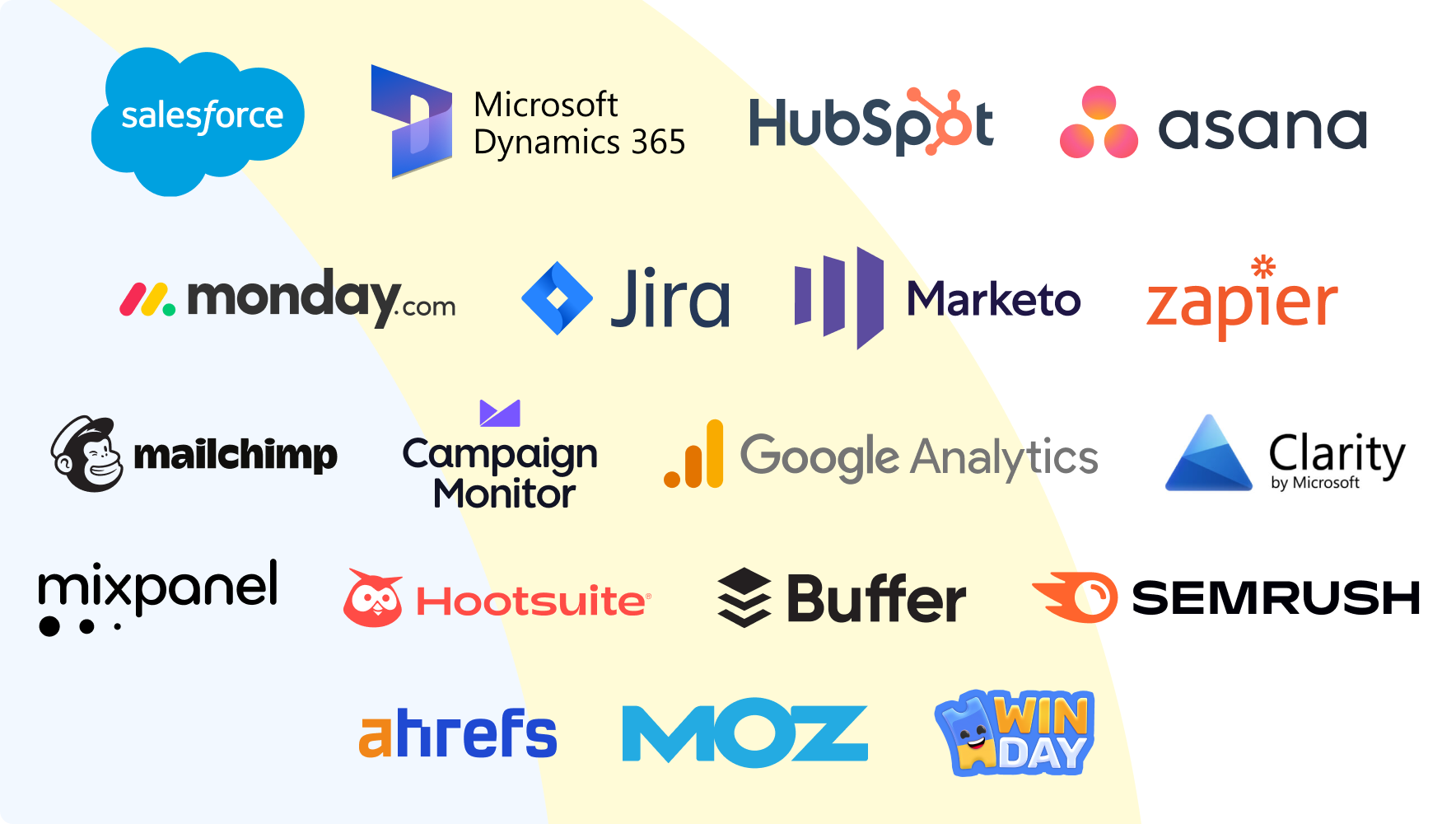
With over 14K solutions for marketers available today, creating your MarTech Tool Stack can be tricky (if not right away exhausting). This guide will help you navigate the overgrown labyrinth of IT solutions and pick the tools that are right for your business and its unique needs.
In this guide you will get answers to the following questions:
- What is Marketing Technology and MarTech Stack?
- What is the Current State of the Market?
- What are the main types of MarTech Platforms?
- What are the Benefits of Top MarTech Platforms in Marketing?
- How to Build the Best MarTech Tools Stack for Your Business?
- What are the future Marketing Technology trends?
How the Right MarTech Stack Can Improve Your Marketing
See how the perfect MarTech tools and gamification improve campaigns. Book a personalized demo to achieve your marketing goals and save costs.
book a personalized demoWhat is Marketing Technology?
Marketing technology, often shortened to MarTech, is the software and digital tools that help businesses plan, execute, and measure their marketing activities. In simple terms, MarTech is the technology that supports modern marketing.
It can be email automation, customer data management, or gamification platforms.
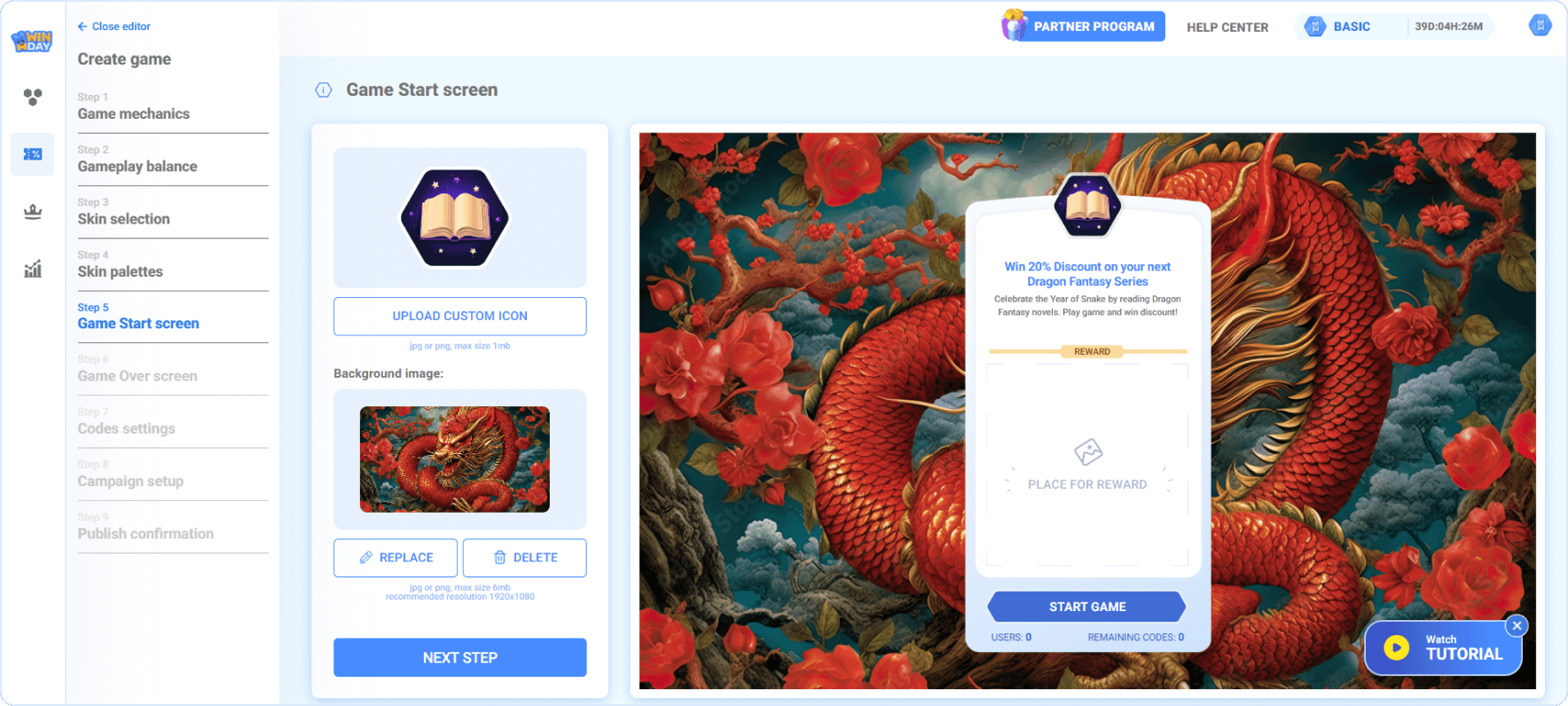
Example of Marketing Technology Platform.
MarTech means any technology that helps businesses reach their target audience more effectively, measure performance, and improve marketing results. MarTech combines marketing and technology. It covers all solutions that make marketing more efficient and scalable.
What is a MarTech Stack?
A MarTech stack is the collection of marketing technologies a company uses to reach customers, improve campaigns, and analyze results.
Traditionally, businesses could use only one tool, but these days most of them combine several: email platforms, CRM systems, social media tools, and analytics dashboards. Together, this stack forms the digital foundation for running and optimizing marketing strategies. Marketing Technology solutions are used to:
- execute and/or automate marketing tasks
- plan and implement marketing campaigns
- monitor and control marketing team
- manage marketing channels
- collect, store, and analyze essential marketing data.
Essentially, you can consider a simple Microsoft Paint as your Marketing Task if you use it to crop images for your website.
MarTech Market Overview
To better understand the MarTech tools market, we looked for the most recent statistics and compiled them into several infographics that you can download and study later. Each image is preceded by a short overview.
With the digitalization of marketing efforts, came the necessity to monitor and control available digital marketing assets like websites, social media, and banner ads. The IT market quickly realized the demand potential of Marketing Tech tools and responded with exponential growth over the past decade.
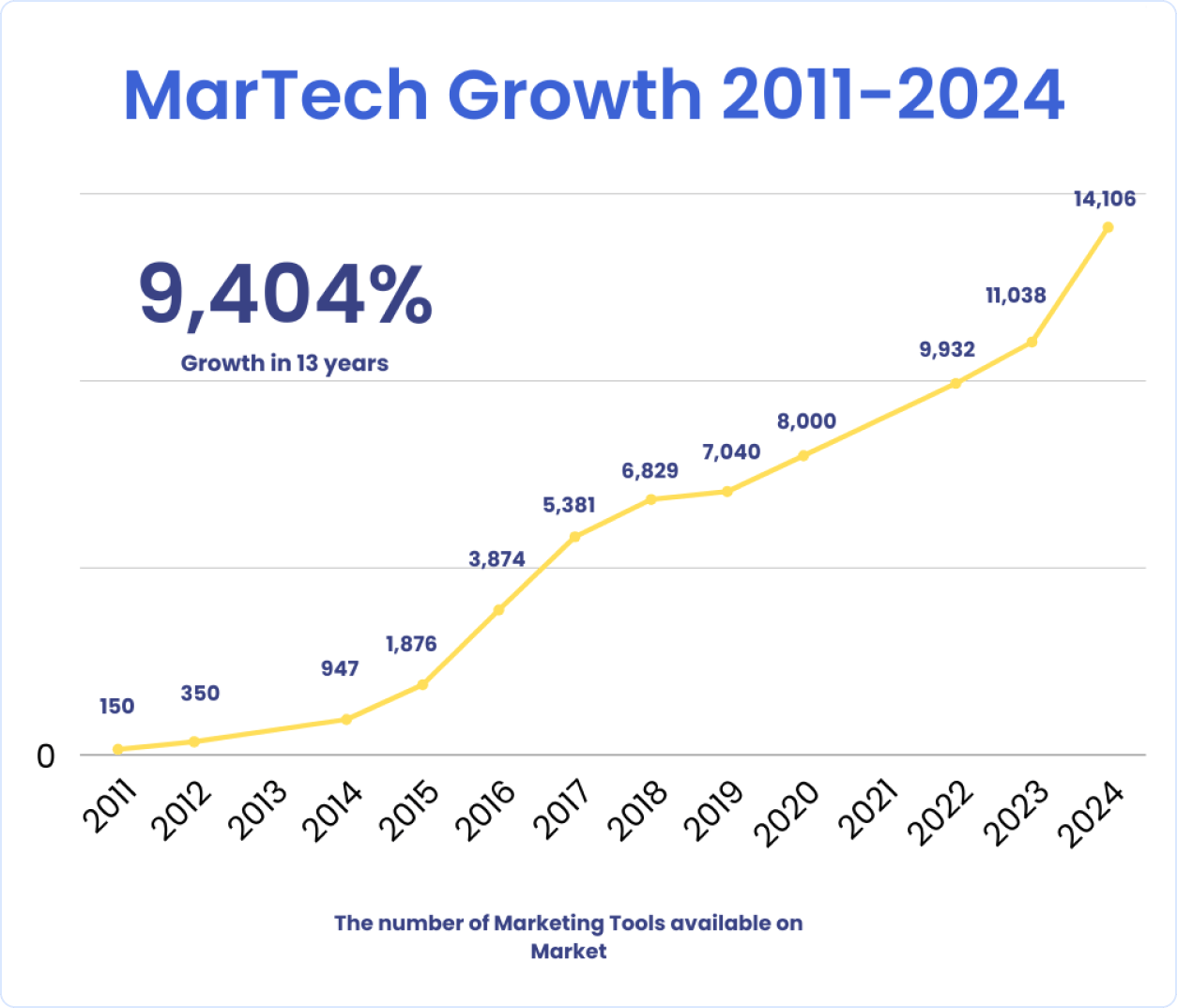
Organizations find marketing technology tools overall useful identifying their impact on company performance higher than average. However, only on average businesses use only 51.5% of all their Marketing Tech Stack.
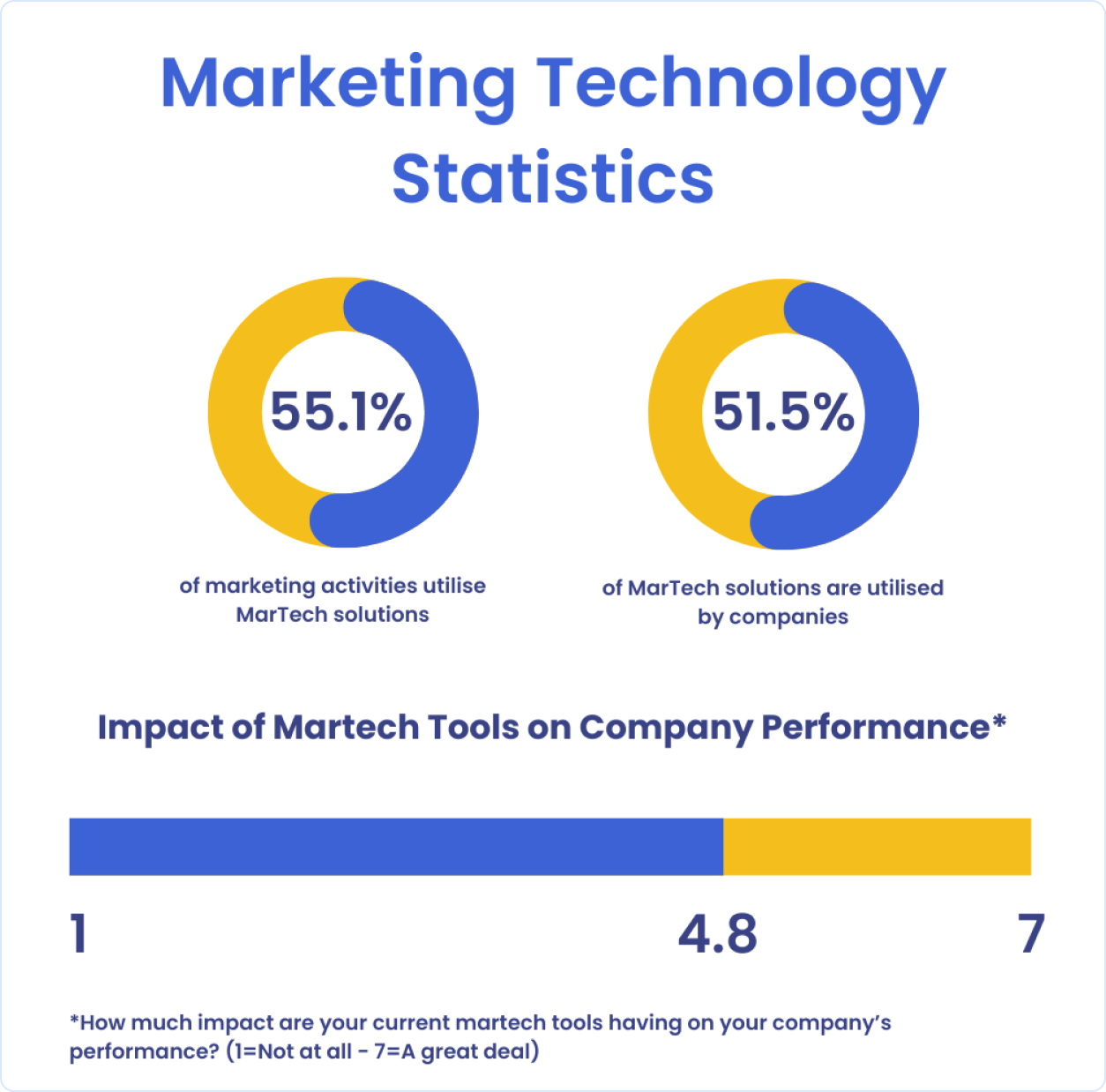
More than three quarters of all businesses use marketing tech tools with mining and construction firms demonstrating the highest use:
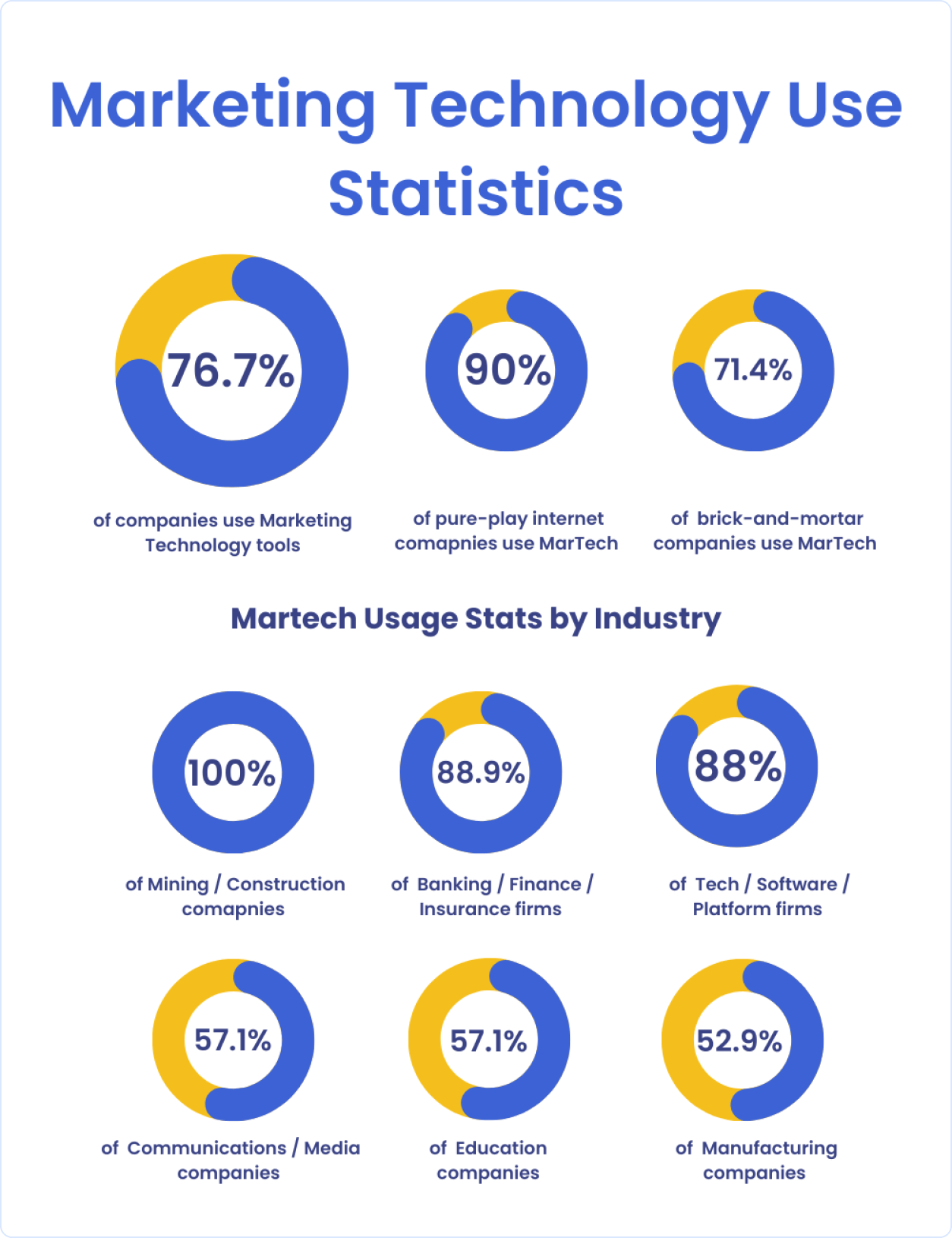
In next 5 years, the spend on marketing technology tools will grow by 67%, with companies spending toward one third of their marketing budgets on these solutions:
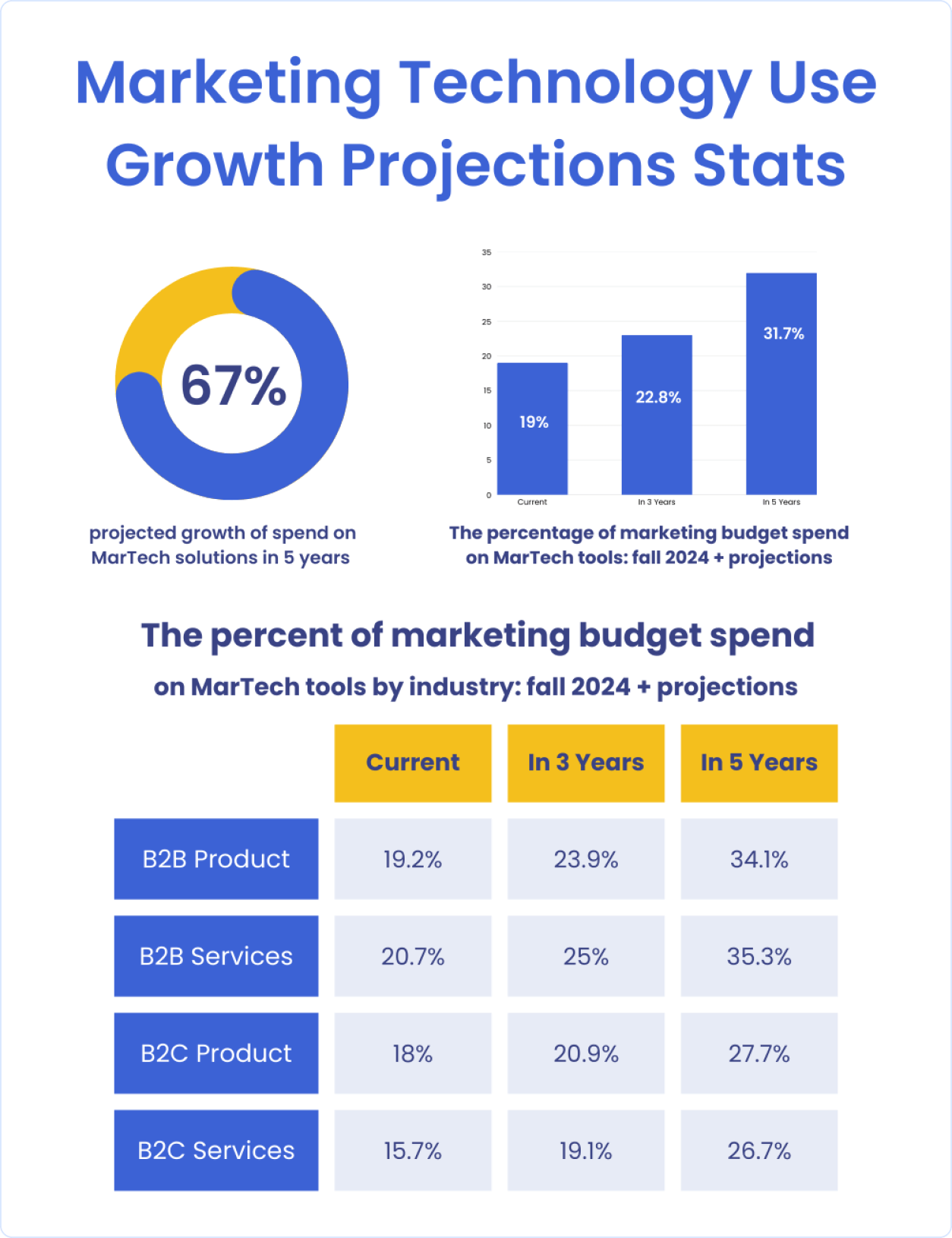
Types of Marketing Technology Platforms with Examples
According to 2024 ChiefMartech research, there are 14,106 MarTech solutions on the market (a 27.8% growth since 2023). With such abundance, it’s hard to make the right choice. In this section we discuss different types of Marketing Technology and suggest the best solutions.
Types of Marketing Technology:
- CRM systems
- Email Marketing
- Data Analytics
- Content Management
- SMM
- SEO
- Gamified Marketing
Let’s take a closer look at each type and check out the best MarTech stack examples in each category.
Customer Relationship Management (CRM) Systems
What is MarTech that you absolutely need to have? The answer is CRM. Managed properly, it stores all the contact data of your customers and logs of past interactions across multiple channels. With the development of AI, your CRM can become the holy grail of customer data to analyze and gain insights.
Salesforce
Salesforce dwells on the pricier spectrum of Marketing tech solutions and is believed to be the primary tool for enterprises. Though it has solutions for SMBs, its compliance and security capabilities are a perfect match for market giants. This tool is highly customizable and if you have a good team of developers you can tweak it as you want to meet your unique business need. On top of it, there are thousands of apps that are built uniquely for Salesforce and can help you get the most out of the CRM.
Pricing: Starter ($25 user/month), Pro ($100 user/month), Enterprise ($165 user/month)
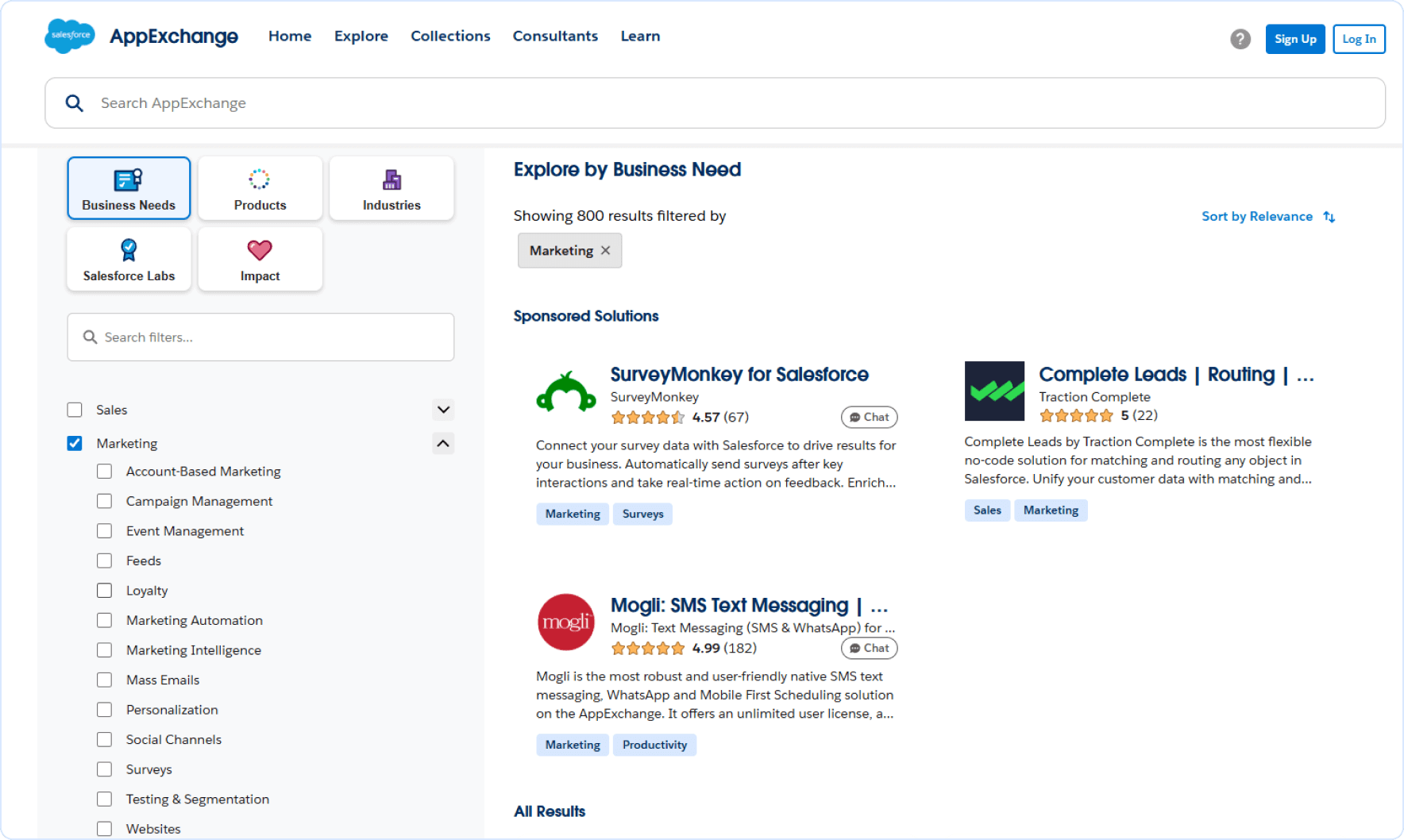
Marketplace for Salesforce Apps offers a lot of MarTech tools.
Microsoft Dynamics 365
Microsoft Dynamics 365 encompasses CRM, ERP (Enterprise Resource Planning) and marketing functionality. It’s a robust solution for large enterprises that want utmost security, compliance and visibility of their corporate resources and sales pipeline. It integrates seamlessly with other Microsoft solutions creating a closed system for the company. It has more features than HubSpot but fewer capabilities than Salesforce.
Pricing: Professional ($65 user/month), Enterprise ($105 user/month), Premium ($150 user/month)
HubSpot CRM
HubSpot CRM has a free version that can satisfy the needs of a small organization. It’s a great launchpad for growing your business. It’s not as customizable as Salesforce, but it offers more MarTech solutions for your team that come as part of a package plan rather than a separate offering.
Pricing: Free, Starter ($15 user/month), Pro ($90 user/month), Enterprise ($150 user/month)
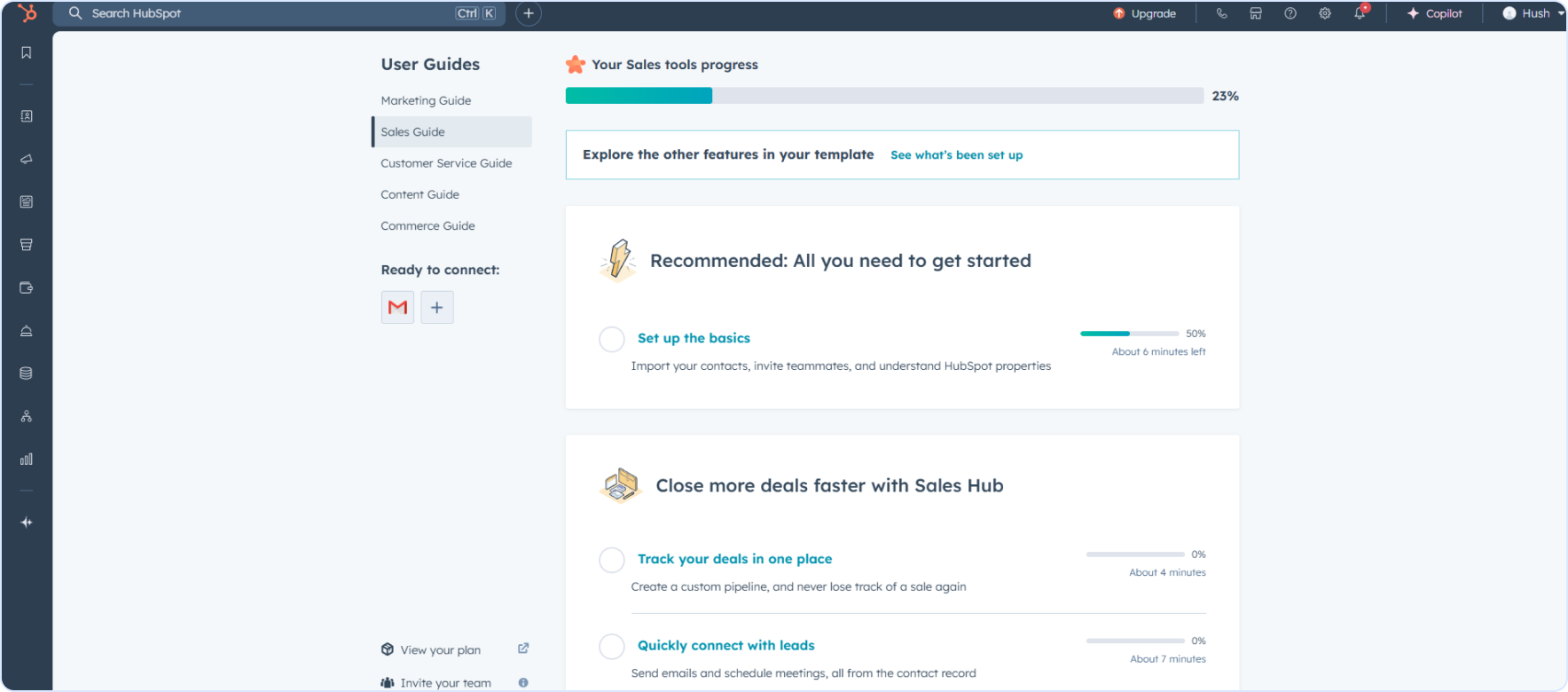
A screenshot of HubSpot free solution.
Project Management Tools
Performance of marketing teams heavily depends on collaboration and precise timing. We suggest looking for marketing tech solutions with the following functionality:
- Functionality for Marketing Calendar.
- Dependencies on other tasks or projects that will help you identify bottlenecks.
- Integrations with other marketing tools.
- Ability to create sub-tasks with different assignee’s.
- Dashboards & Reporting for a bird’s eye view on your team’s performance.
Unfortunately, marketing teams do not always have the freedom to choose the Project management tools as often these are solutions that are bought for the whole organization. As a result, you can end up with a marketing technology software that doesn’t match all your needs. In this case you can consider plugins.
Asana
Asana is considered one of the best tools for marketers. It’s user-friendly and is great for task management as it offers subtasks and dependencies. It has Kanban boards but can easily switch to Calendar or Gantt Charts for a bird’s eye view on your projects.
Pricing: Free, Starter ($10.99 user/month), Advanced ($24.99 user/month), Enterprise & Enterprise + (custom prices).
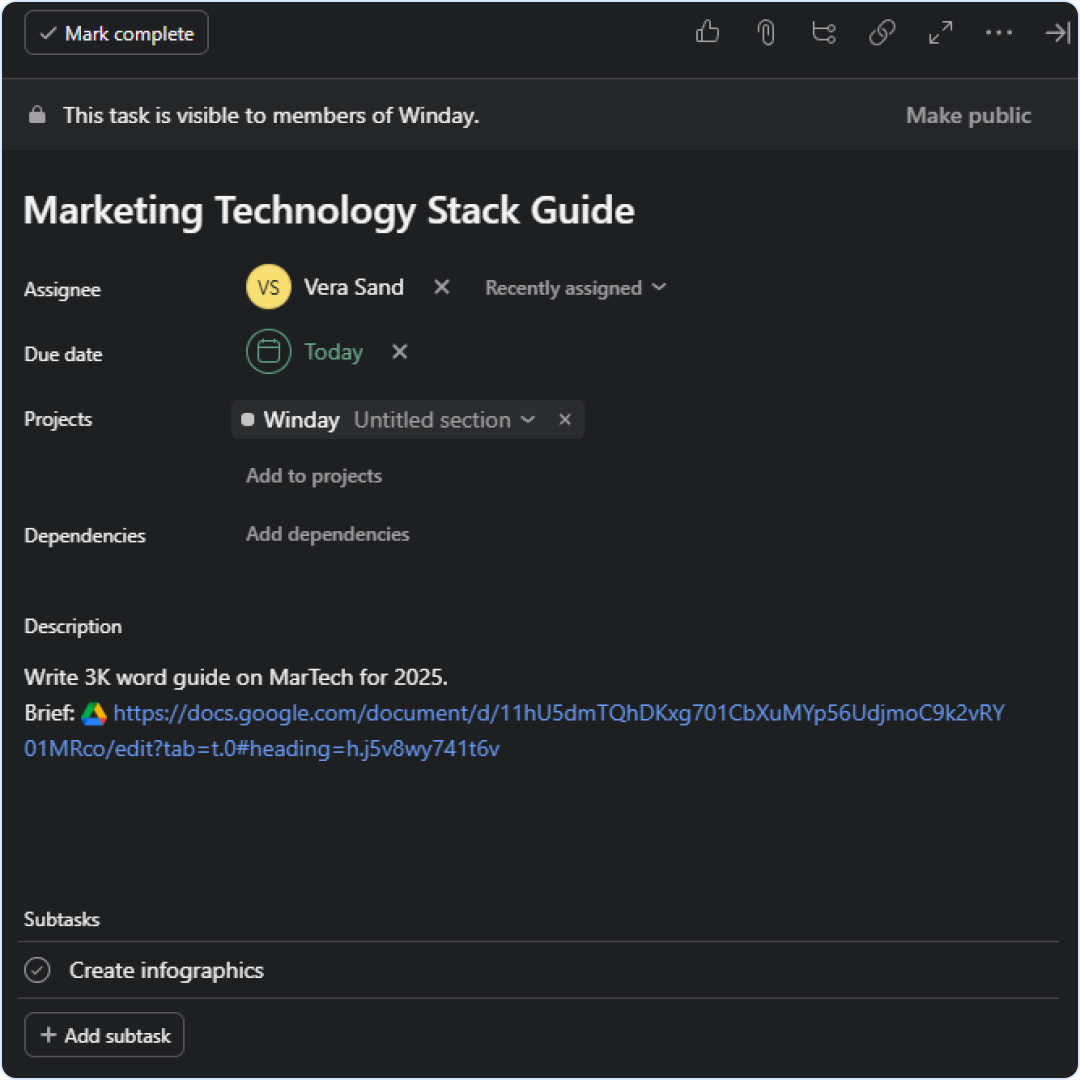
An example of task board in Asana.
Monday
Monday is very similar to Asana, but it’s slightly cheaper and has more features like budget tracking and project portfolio. It has also introduced an AI assistant that can generate and summarize tasks for you and your team as well as offer optimization of your workflows.
Pricing: Free, Basic ($9 user/month), Standard ($12 user/month), Pro ($19 user/month), Enterprise (custom prices).
Jira
You won’t see this tool as often in a Marketing Tech stack, as Jira is widely used in the developers community, and it was created with Agile project management in mind. That’s why it has Kanban boards. It enables you to log your work time for better reporting. Overall, Jira might seem less user-friendly compared to other similar tools.
Pricing: Free, Standard ($7.53 user/month), Premium ($13.53 user/month)
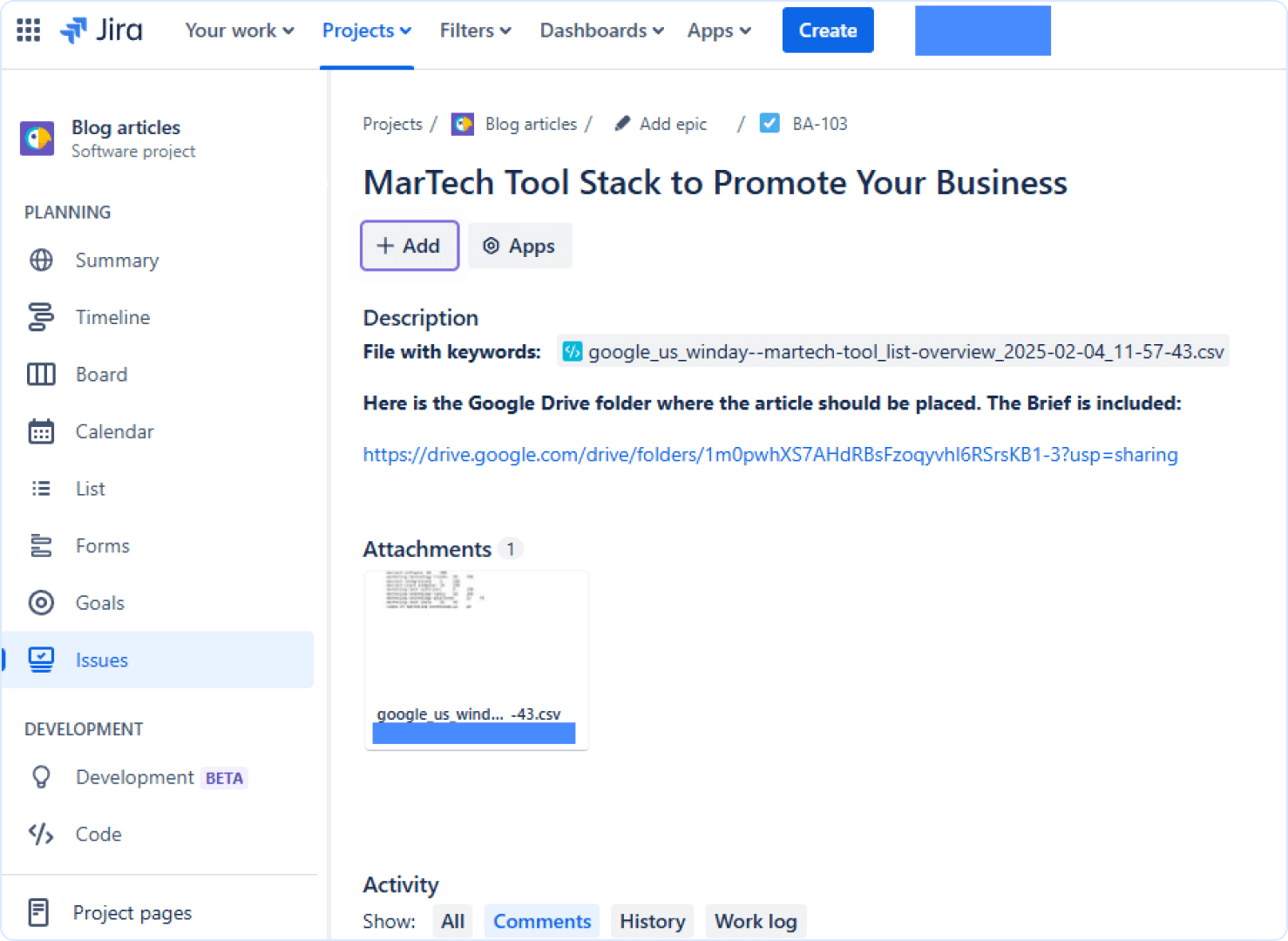
An example of Jira functionality.
Marketing Automation Tools
One of the most important solutions in your Marketing Tech Stack, marketing automation helps your team focus on more creative and intelligent-intensive tasks, leaving the mundane and repetitive to the IT solution. Engage with potential clients and nurture leads en masse across multiple channels, while keeping your communications personalized.
Marketo
Acquired by Adobe Corporation in 2018, Marketo offers powerful features to engage with your potential and existing customers, helping you keep your pipeline visible and predictable. It has a solid number of MarTech integrations and works across all the major marketing channels. Recently it added AI capabilities to empower its users with more features.
Pricing: (according to CrozDesk) Spark ($895 user/month), Standard ($1,795 user/month), Select ($3,195 user/month)
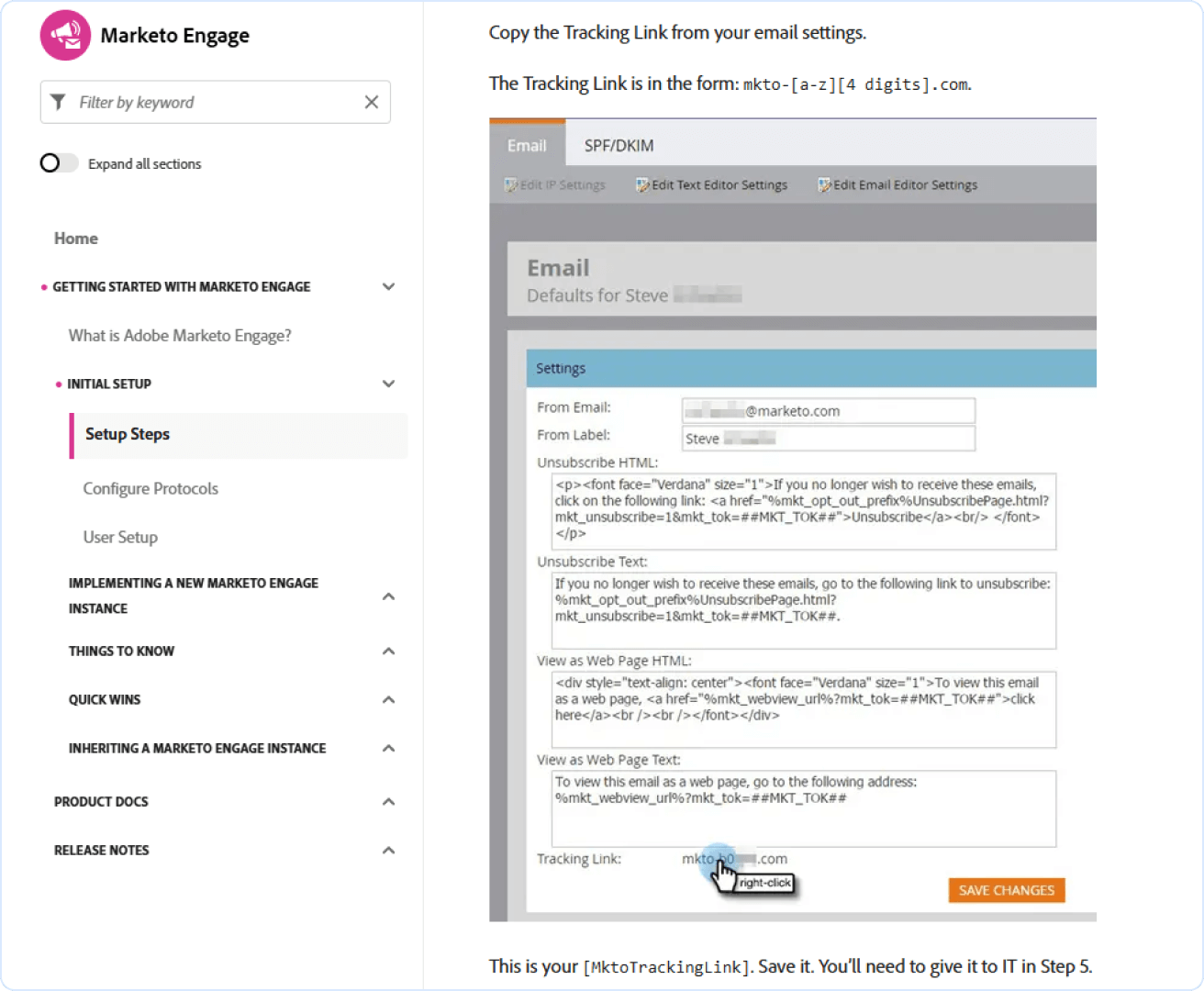
Marketo is a complex MarTech software that requires a lot of fine-tuning from an experienced specialist.
Zapier
Zapier offers codeless automation for marketers that includes lead handoffs, PPC campaigns, emails, lead nurturing, SMM, AI transcripts summarization and many more. With 7,000+ MarTech integrations, it can automate seamless workflows across your Marketing Technology stack.
Pricing: Free, Professional (from $19.99 per month), Team (from $69 per month), Enterprise (Custom pricing). Price depends heavily on the number of tasks per month. For example, the Professional Plan will cost you $49 per month for 2,000 tasks.
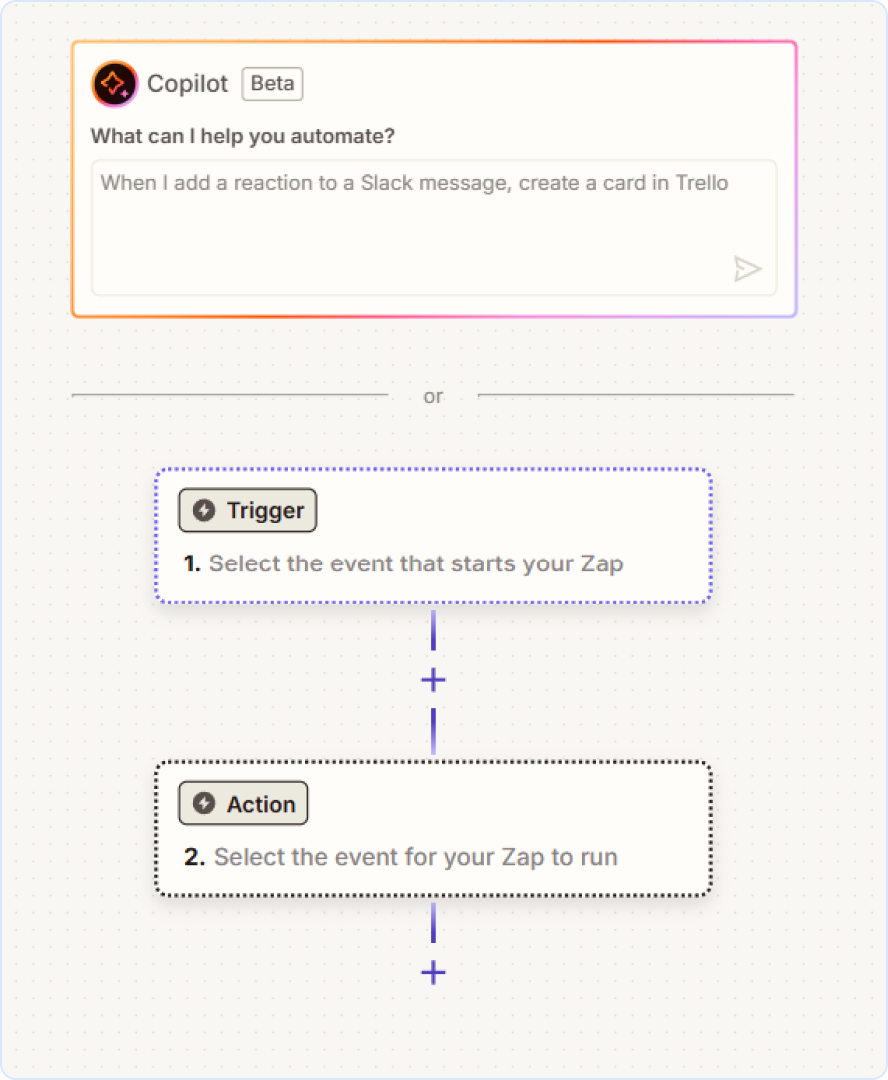
An example of automation task creation in Zapier.
Email Marketing Platforms
Email marketing is the most automated marketing channel, with 58% of marketing decision-makers automating their email outreach. This top MarTech platforms are great solution for communication with your customers when you want to capture their attention and they remain efficient despite decades-long criticism and scepticism of some marketers. We prepared two examples of MarTech tools for email marketing.
Mailchimp
Mailchimp is an easy marketing technology software for beginners with zero experience in email sendouts. Easily manageable solution, it offers a lot of MarTech integrations. The key features include email templates, builder, and sign-up forms. It also has functionality for marketing automation and landing pages.
Pricing: Essentials ($13 per month), Standard ($20 per month), Premium ($350 per month).
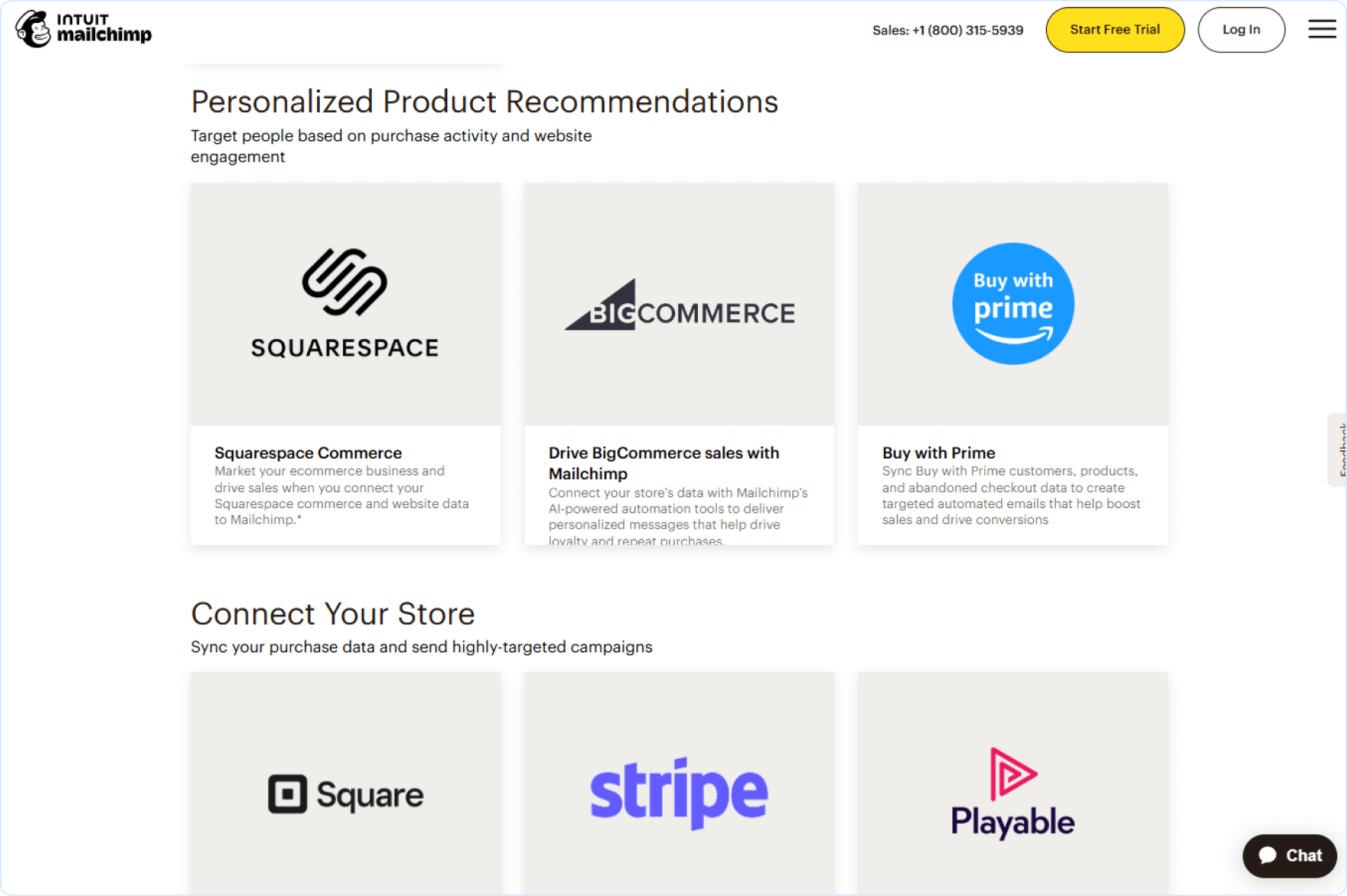
MailChimp has over 300 MarTech integrations.
Campaign Monitor
Campaign Monitor is a slightly cheaper tool for Email Marketing compared to MailChimp, Campaign Monitor offers fewer features. It’s easy to set up and use. You can easily learn to do it in a course of just one day.
Pricing: Lite ($12 per month), Essentials ($29 per month), Premier ($159 per month).
Analytics and Data Platforms
Efficient performance of the marketing team heavily depends on the available data about customer behavior. Analytics MarTech platforms collect, store and process data, providing valuable insights into the customer behavior.
Google Analytics
Google Analytics belongs to the category of must-have Marketing Tech tools if you want to understand how your website performs and make necessary changes. It provides a complete overview (historical and in real time) of the traffic to your website. Learn which page attracts the most visits, which page has the biggest bounce rate, where people spend most time, and how they move from one page to another.
At first, GA4 is akin to rocket science. It’s massive, and you’ll need some weeks or even months to learn all the ins and outs, but it’s totally worth it.
Price: GA4 is free.
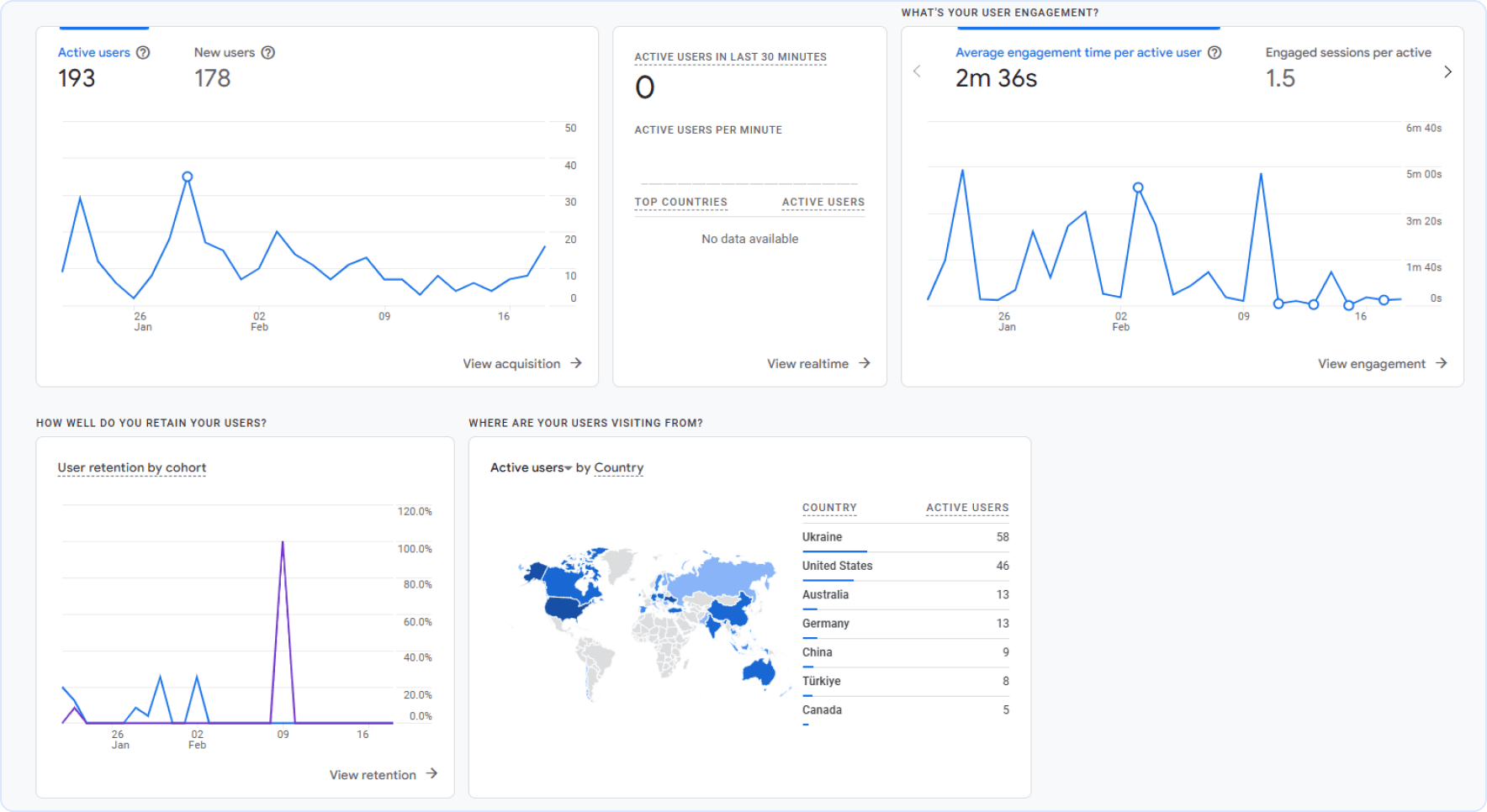
Screenshot of GA4 Reports snapshot.
Microsoft Clarity
Microsoft Clarity is a great addition to Google Analytics and a must-have tool in your Marketing Tech Stack, Microsoft Clarity sheds light onto the website visitors behavior. While GA focuses on visits and transitions between pages, MC demonstrates what people do while on your website. Heatmaps show the “most popular” places of your website: buttons, scrolls and (!) non-interactive spaces that people click thinking they can get the result. Record sessions of users allow you to see how people journey from one page to another, where they have troubles with your website, and where they scroll without engaging with content. It’s a great MarTech software to understand how to improve your content and your UX.
Price: Free.
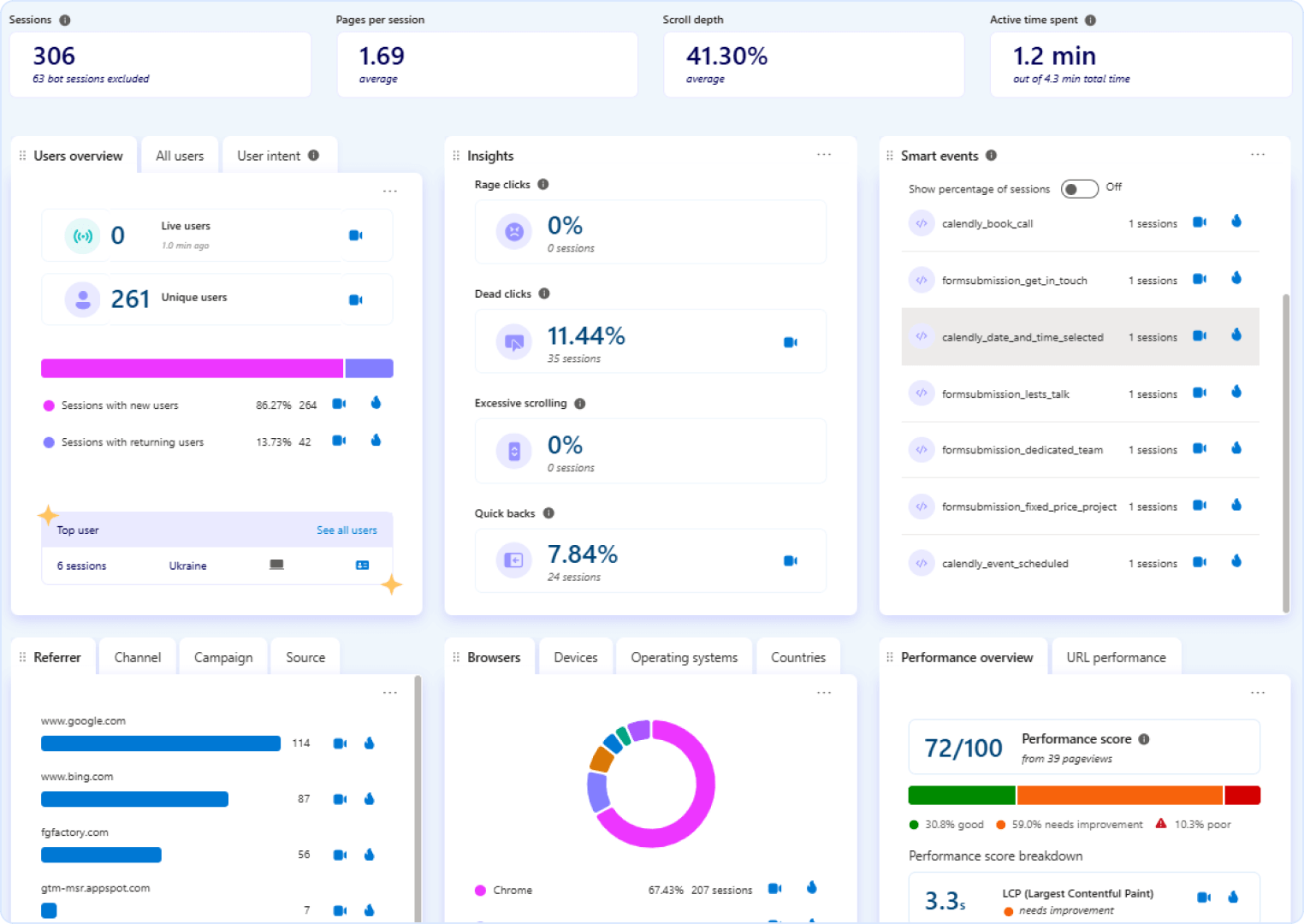
Screenshot of Clarity Project Dashboard.
Mixpanel
Mixpanel is a MarTech software for SaaS products. It is similar to MC and GA as it tracks user behaviour. The difference is that it tracks behaviour inside the SaaS tools. It can become an alternative to user research for UX teams, showing the blockers and gaps in user experience.
Price: Free, Growth (1M events free + $.00028 per event over the limit), Enterprise (custom prices).
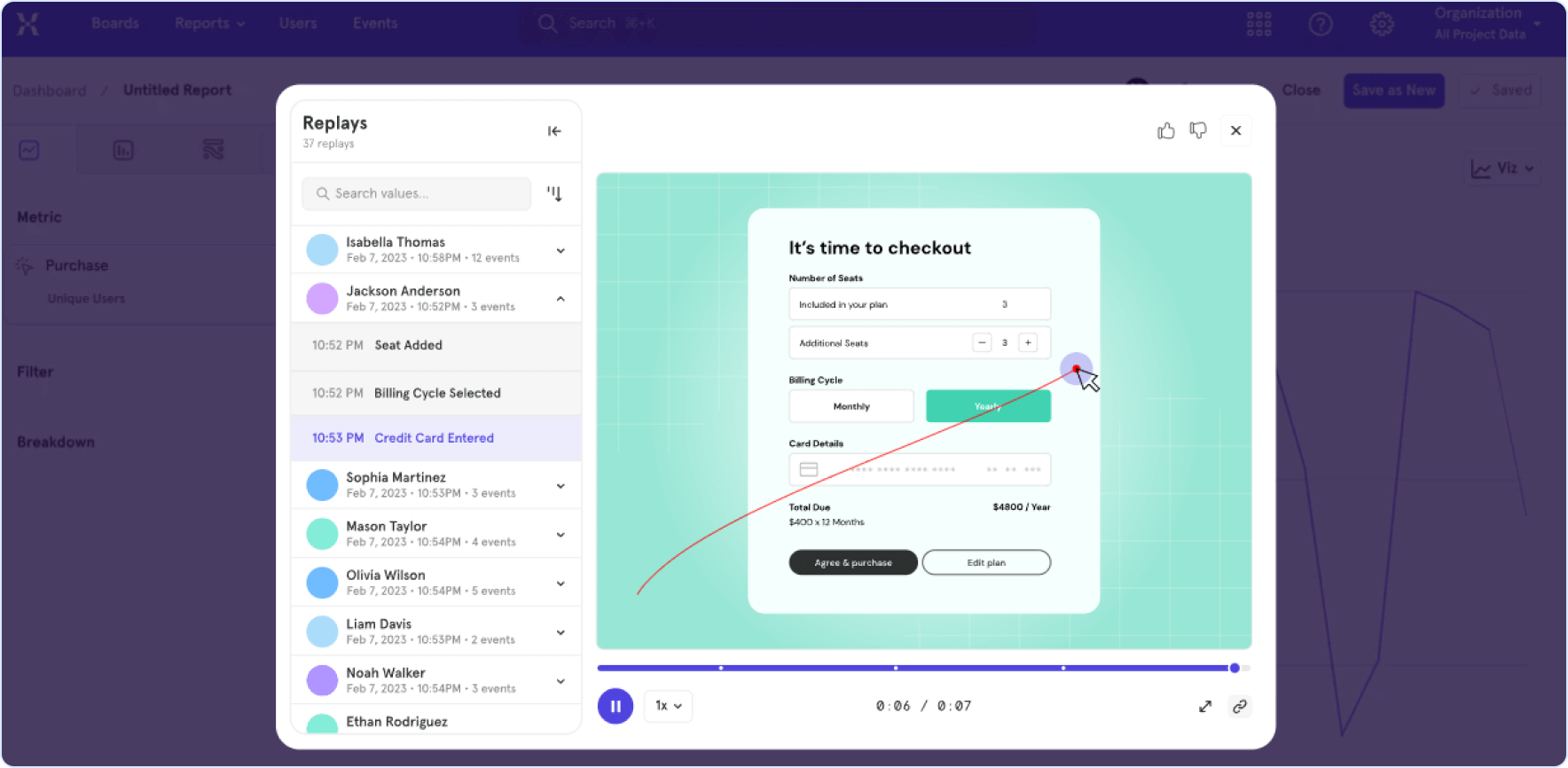
An example of replay functionality.
Social Media Marketing Tools
Social Media is a must-have marketing channel for many brands. What is Marketing Technology for SMM and why do you need it? MarTech tools can help you schedule your postings and analyze the impact they have on your community.
Hootsuite
Hootsuite is one of the most robust marketing tech tools for advanced social media marketing. Apart from traditional features like post scheduling and in-depth analytics Hootsuite also helps your brand communicate with your audiences faster and more efficiently. You can get all comments and DMs on your SMM accounts in your Hootsuite inbox and even set up automatic responses if necessary. It’s a more expensive solution compared to those available on the market, however, its features will help you lead your SMM with ease, and it has a lot of MarTech integrations.
Pricing: Professional ($99 per month), Team ($249 per month), Enterprise (Custom pricing).
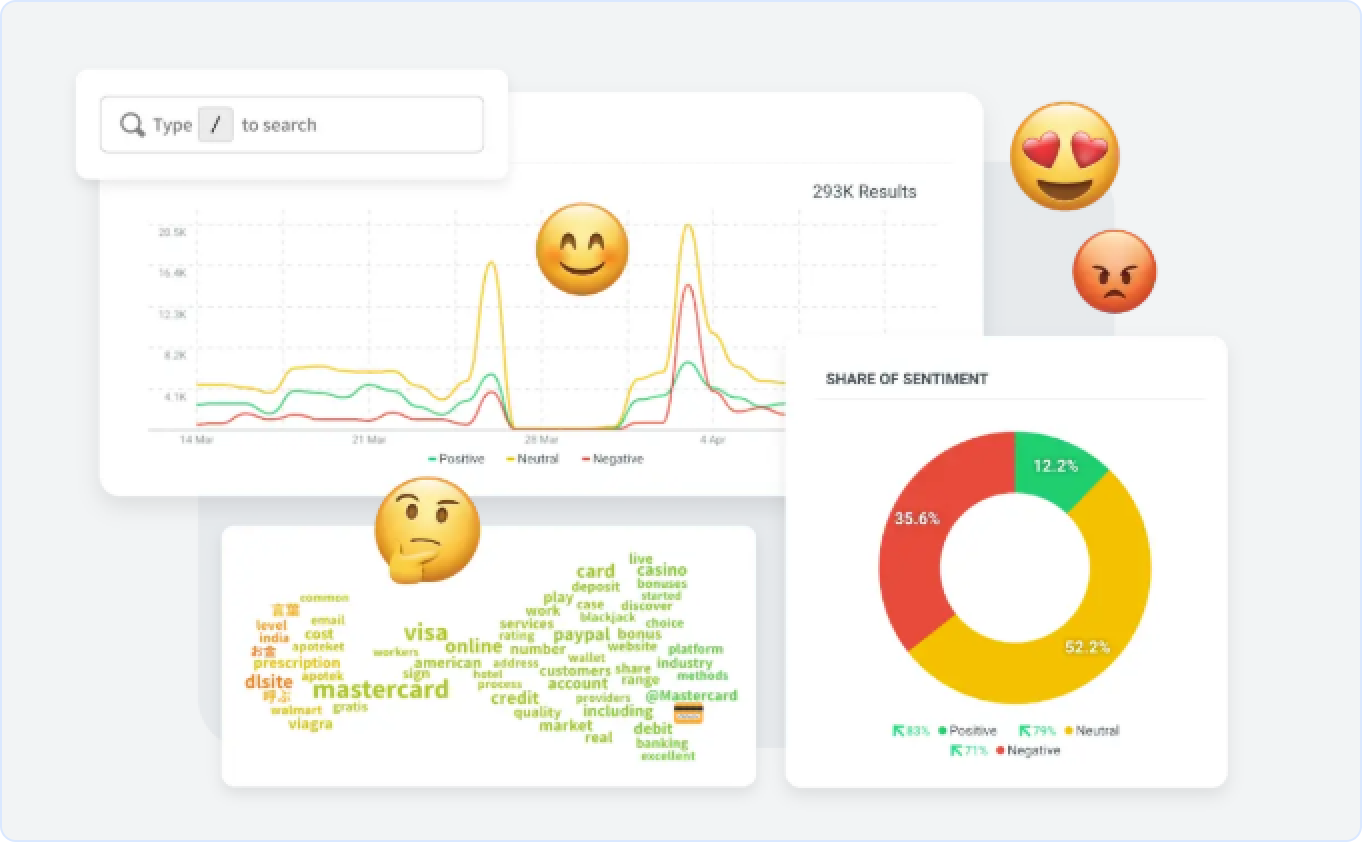
Hootsuite Social Listening Feature can tell you what people are thinking and feeling about your brand right now.
Buffer
Buffer is a cheaper option for Social Media Marketing, Buffer has a free plan with one available channel. The tool enables you to create and schedule posts, manage conversations in comments, and analyze the engagement levels of your posts.
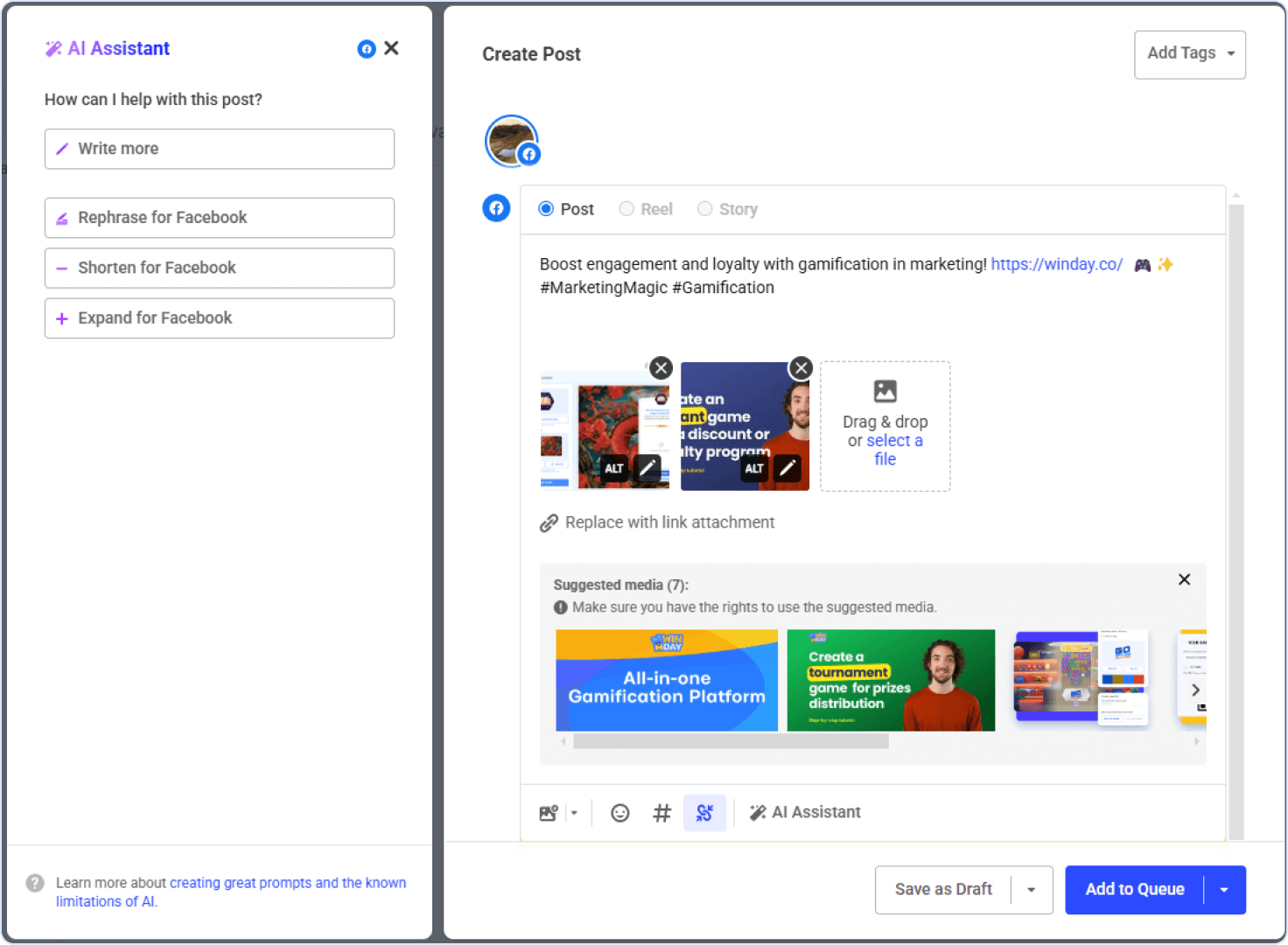
An example of content created by Buffer’s AI.
Pricing: Free, Essentials ($5 per month per channel), Team ($10 per month per channel).
Search Engine Optimization (SEO) Tools
Search Engine Optimization tools help marketing teams achieve their SEO goals, like bringing more traffic, improving conversions and generating high-quality leads.
SEO tools can help you with the following tasks:
- Keyword research
- SEO Audit
- Backlinks Audit
- Website rankings in search engines
- Competitors rankings analysis
Semrush
Semrush is a robust MarTech software with functionality that covers the majority of SEO tasks. These are keyword research and tracking, backlink analysis, SEO Audit including crawlability, Core Web Vitals, performance and internal linking. Additional functionality includes content marketing assistance, social media features and PPC. Some SEO specialists reported errors in estimating the traffic, but overall it’s a really great tool if you have the budget.
Pricing: Pro ($139.95 per month), Guru ($249.95 per month), Business ($499.95 per month). Keep in mind that you will receive access for 1 user (the attempt to log in from another PC might get you kicked out of the platform). Additional users cost $45, $80, or $100 per month depending on the plan.
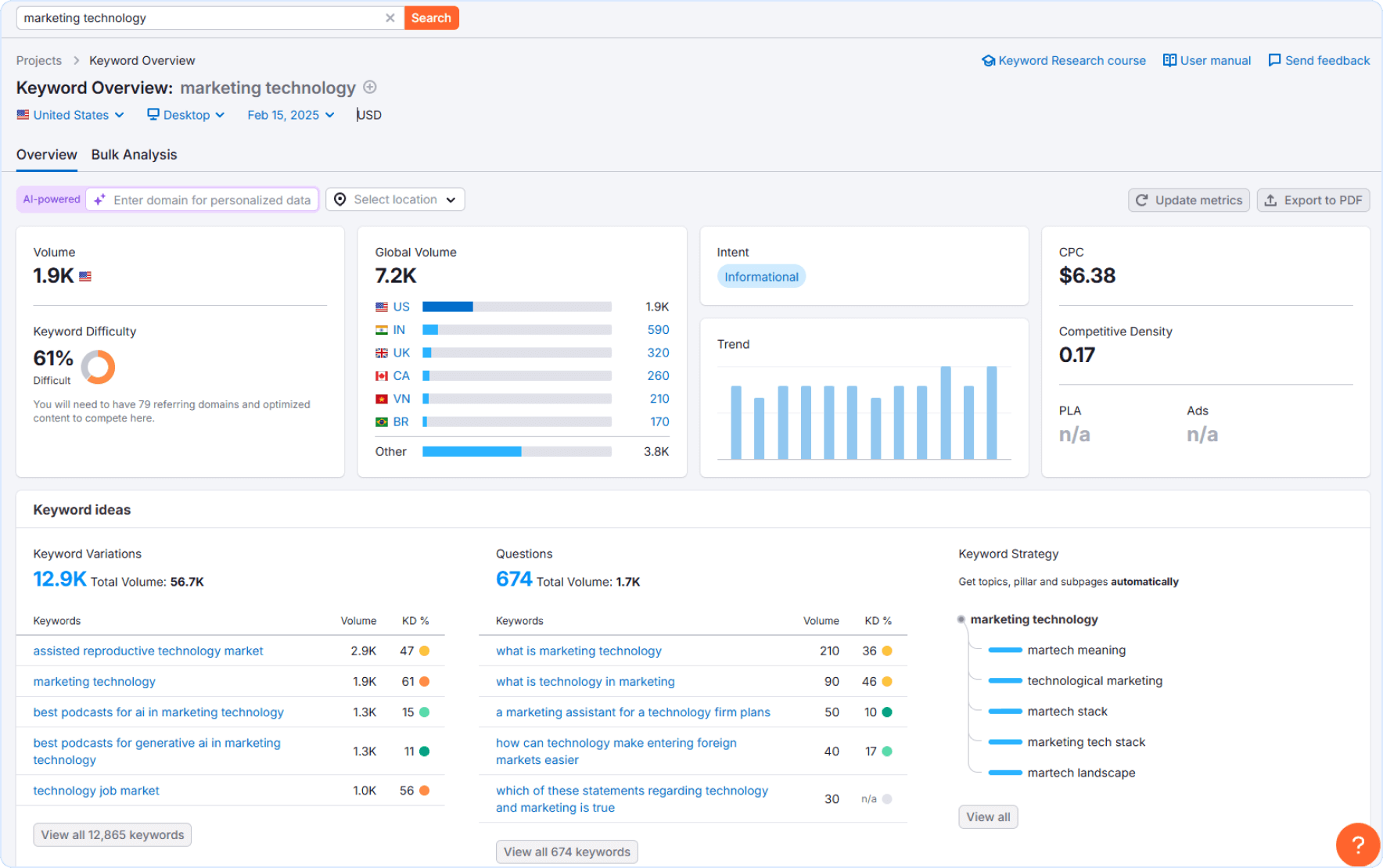
An example of keyword research in SemRush: the keyword analytics is followed by suggestions of related keywords.
Ahrefs
Ahrefs offers functionality similar to Semrush like keyword tracking and research, backlinks, website audit, and performance history. However, it doesn’t offer content marketing, social media or PPC features.
Pricing: Lite ($129 per month), Standard ($249 per month), Advanced ($449 per month), Enterprise ($1,499 per month). The price is per 1 user. Each plan has a limit to users you can include and each additional seat will cost you $40, $60, or $80 per month depending on the plan.
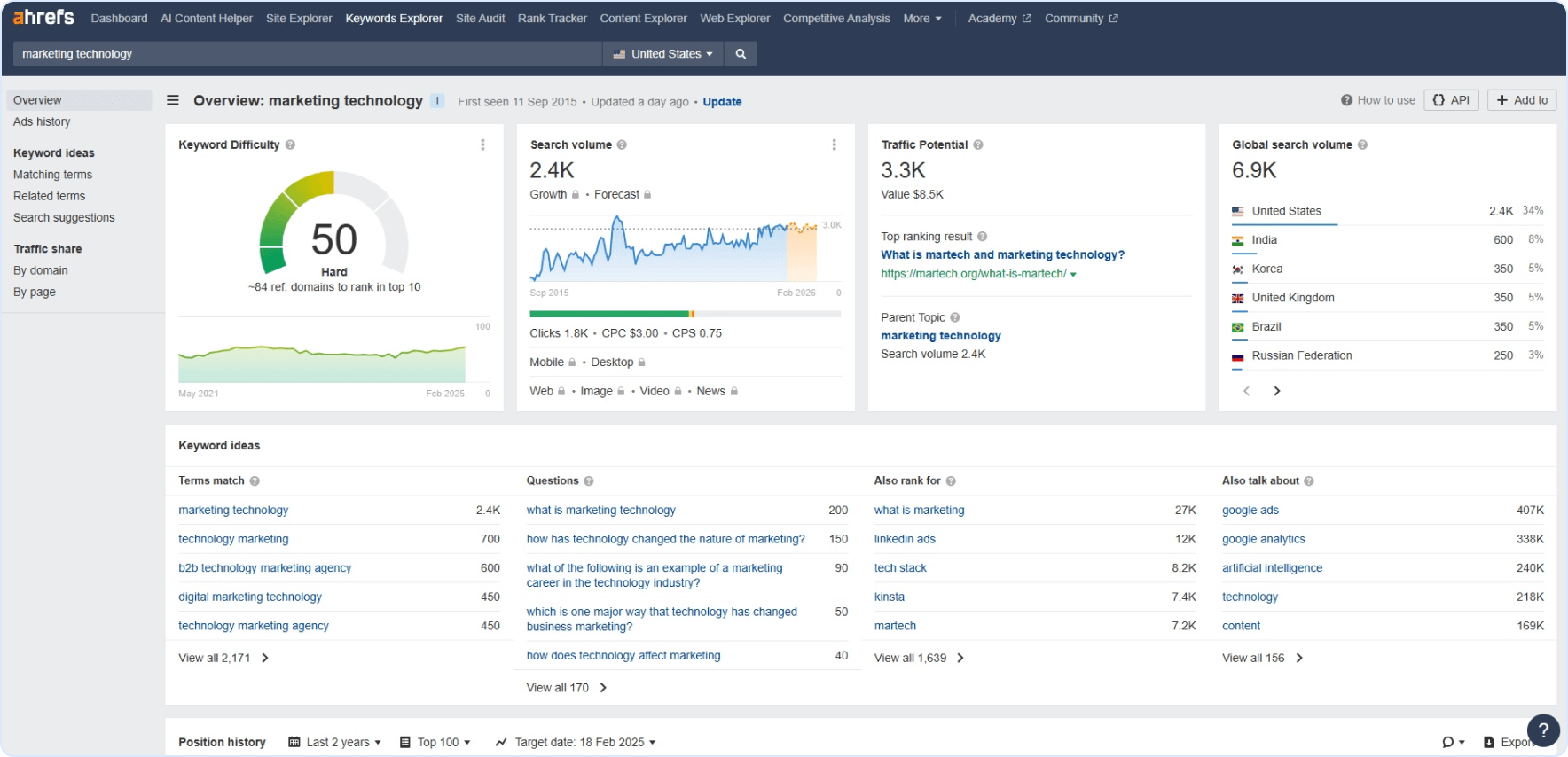
An example of keyword research in Ahrefs: the keyword analytics is followed by keywords ideas and statistics.
Moz
Another platform in the category of MarTech solutions for SEO, Moz has even fewer features than Ahrefs, but it also costs significantly less. You won’t find content marketing tools, PPC, social marketing, or website audit. On the other hand, it has a robust educational base on the best SEO practices and helps with on-page optimization. It’s a good option for SMBs with limited marketing budgets.
Pricing: Lite ($129 per month), Standard ($249 per month), Advanced ($449 per month), Enterprise ($1,499 per month). The price is per 1 user. Each plan has a limit to users you can include and each additional seat will cost you $40, $60, or $80 per month depending on the plan.
Gamified Marketing Platforms
Gamified Marketing is the new black for B2C businesses. People’s focus is scattered all over the place. Customer acquisition cost is an all-time high and so is the cart abandonment rate. Attracting customer attention and retaining it is increasingly hard. You need to entertain your potential clients. Due to their impact on human psychology, games are an efficient way to achieve your marketing goals.
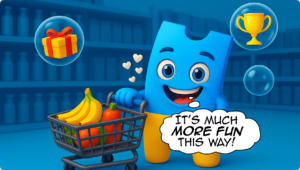
For the longest period of time, incorporating video games was too expensive and only the biggest brands could afford in-house development teams. Luckily, MarTech evolution has brought us to the point where marketing gamification platforms offer easy codeless game creation and integration.
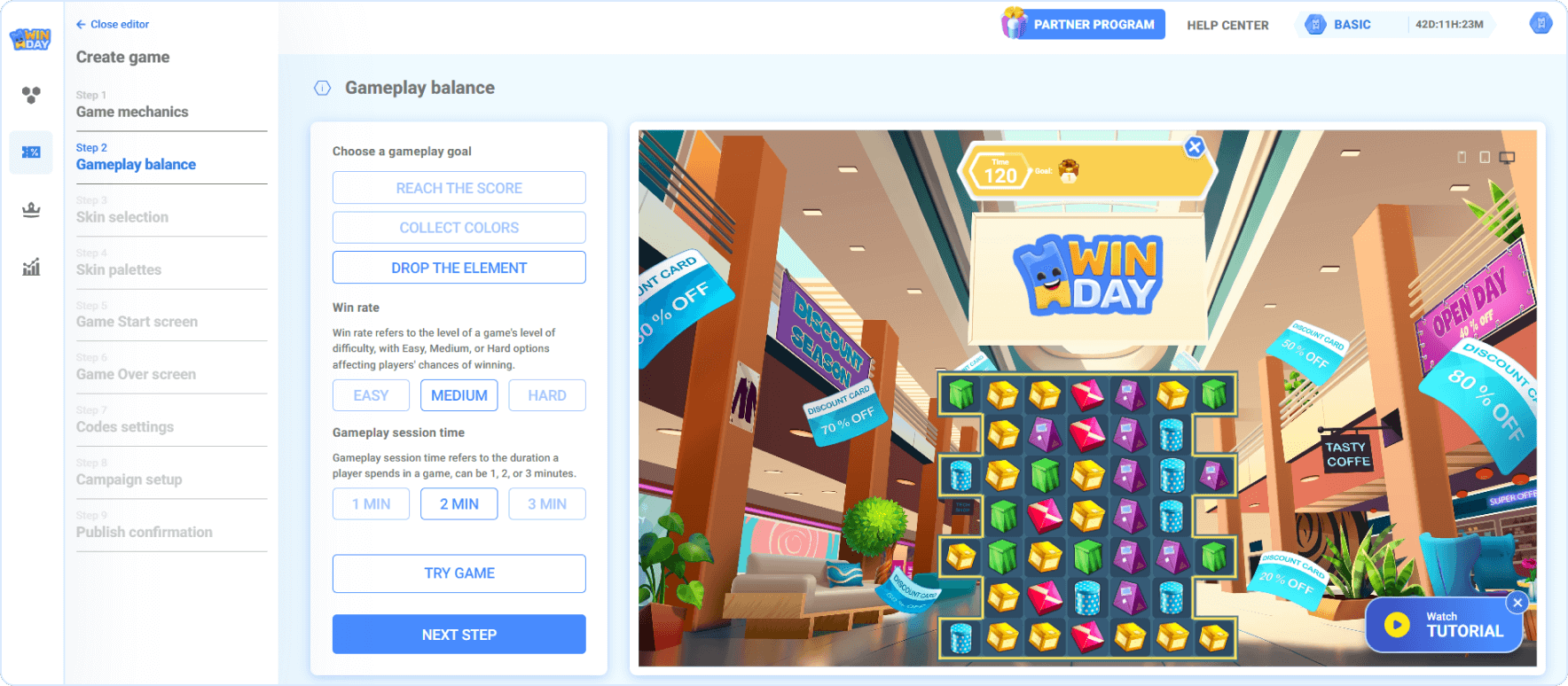
An example of a gamified MarTech Platform.
Benefits of marketing gamification platform:
- Attract attention with unusual activities.
- Boost customer engagement.
- Increase conversions and sales.
- Improve customer retention.
- Build brand awareness and loyalty.
Winday
Winday is a marketing gamification platform that enables you to create games in less than 30 minutes, saving 99% of time and budget on development. You can then integrate the game in your website, web application, and Telegram bot. You can also share it using links or QR-codes.
Furthermore, You can create several types of game with different requirements for winning. Set up how your customers will receive gifts: instant win games or after completing a tournament and getting a prize seat. You can also create games with limited access to boost retention of your existing customers.
Pricing: from $20 per month that includes multiple ongoing marketing campaigns.
Start Creating
Create branded marketing games in minutes without coding and technical skills.
start your free planBenefits of Top MarTech Platforms in Marketing
As previously mentioned, marketing technology platforms have a significant impact on your team performance and goal achievement. In this section we’ll explain how choosing the right marketing technology solutions can improve your team’s efficiency and boost the performance of your advertising campaigns.
- Data-driven decision-making. MarTech tools can collect and analyze data to help marketers make informed decisions on their ongoing and upcoming campaigns.
- Automation. Martech can help you decrease the workload of your team while ensuring that tasks are completed in time.
- Productivity. Marketing tech solutions helps companies complete certain tasks much quicker while the team is focusing on the more creative tasks.
- Error reduction. IT tools can significantly reduce the number of human errors that are inevitable in everyday work, from simple spell-checkers to task reminders.
- Cost-efficiency. With faster task completion, fewer errors, and automation, companies can be sure that their marketing ROI will remain in check.
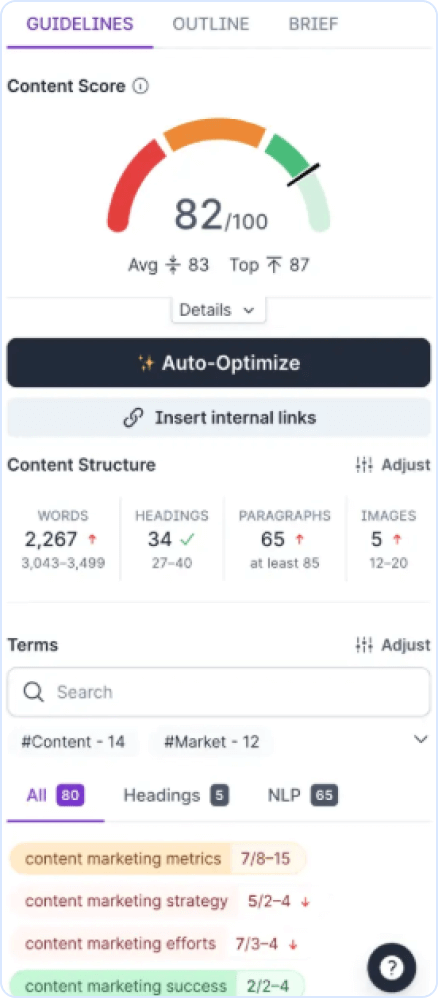
An example of Surfer’s SEO functionality. It analyzes Google SERP in the assigned region within a minute, providing suggestions on the number of words, paragraphs, images, and related keywords – a task that could take a seasoned content marketing specialist several hours of work.
How to Build the Best MarTech Tools Stack for Your Business
48.9% of MarTech tools of a company aren’t used. Learn how to build and optimize your MarTech Stack and make the most of every tool you pay for.
Marketing Technology Stack is the part of the general Tech Stack of the company that is used to achieve marketing goals. It can be purchased and managed by the marketing team or by the IT team upon the request of marketing. Part of your MarTech stack will most likely remain in shadow meaning you will have no idea your team is using it until something unexpected happens to the technology. In undesired scenarios, part of your MarTech platforms will be used by your former employees.
Managing MarTech platforms isn’t the easiest task and has a number of pitfalls like compliance and security concerns. We suggest working with your legal, IT security and finance departments to ensure the best ways of managing your team’s tech stack.
How to choose the right MarTech Stack for your Business?
If you’ve been in marketing for a while you sure have seen MarTech stack examples where several tools have been regularly paid but not used, and some tools had duplicate functionality. To avoid the resulting unnecessary marketing spend, we suggest approaching your Marketing Tech Stack as a whole rather than a collection of siloed solutions.
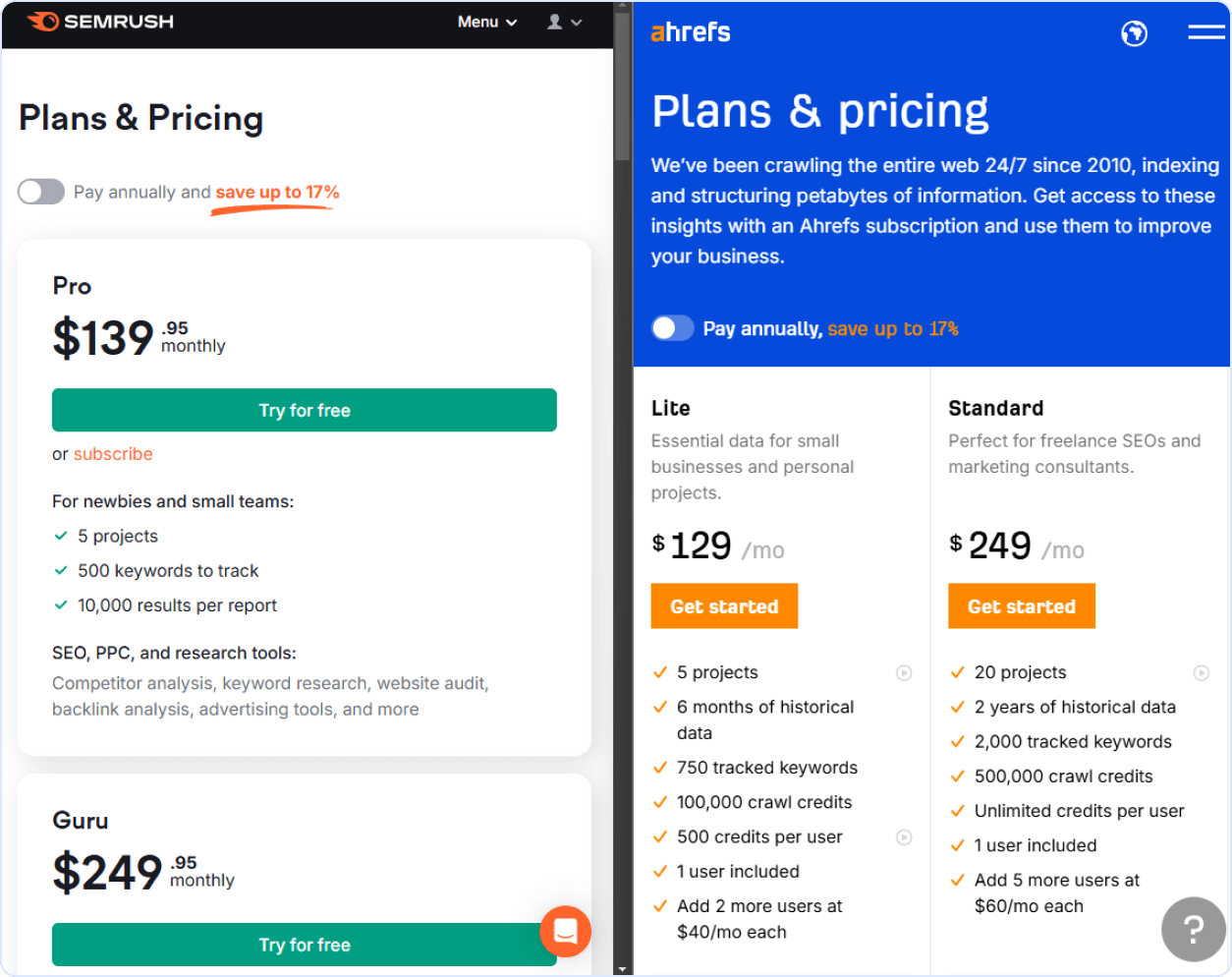
Example of SemRush and Ahrefs offerings with similar functionality.
The essential steps to build the MarTech Stack:
- Determine the budget spend on your TechStack
- Analyze your existing marketing technology tools
- Analyze your current marketing processes
- Assess the automation of your marketing tasks
- Identify the tasks and processes that can be automated
- Outline which processes you want to run but can’t because you lack necessary tools
- Define which tools from your stack have almost identical functionality and decide which tools to remove
- Ask your legal and IT security team about requirements and limitations on tool acquisition
- Study the market and identify which tools meet your needs
- Start using tools with free trials to see which of them meet your company needs and marketing team processes
🔝 Tip
Ask your team what tools they use, you might learn a lot of new things.
Future Marketing Technology Trends
In this section, we share our opinion on the ongoing marketing technology trends that will shape the industry in the future.
AI in MarTech
When talking about AI in MarTech, the first thing that comes to mind to many people is content generated by AI. While artificial intelligence has achieved excellency in creating sophisticated copy, the use of it in many business contexts is problematic. The main concerns include:
- A third-party tool accesses and may be store sensitive business data (including PII of customers and employees);
- Google allegedly punishes AI-generated content ranking pages with such content lower compared to human-generated;
- Copyright to the content generated by AI doesn’t belong to the company that uses AI (and can be claimed by the AI developers).
That’s why we strongly suggest consulting with your legal and cybersecurity teams on the scope of use of AI.
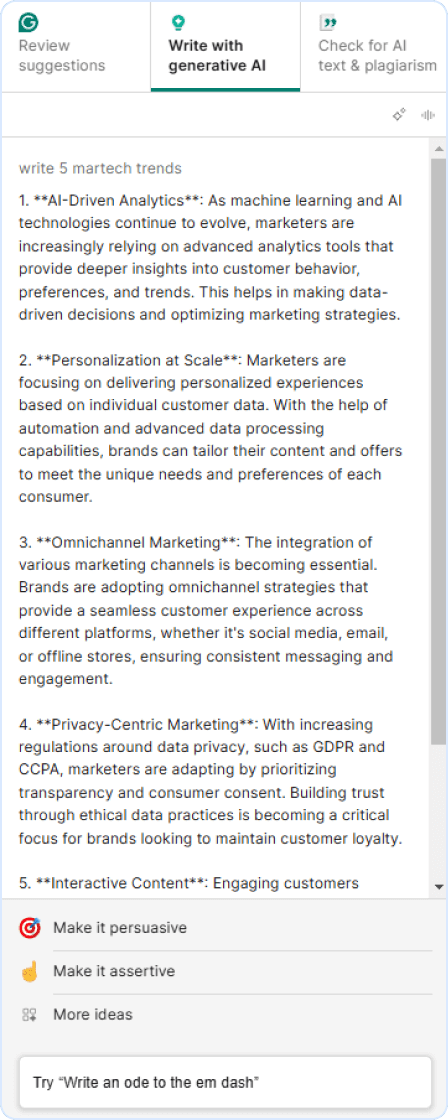
An example of AI tool in Grammarly.
This being said, we want to emphasize that we strongly believe that more AI MarTech solutions will be used in MarTech over the years. According to IBM, 2024 was the year of AI agents, AI tools that are integrated into existent IT systems to solve complex problems. They are predicted to be used in the following environments:
- AChatbots
- Booking systems
- Budgeting
- Forecasting
- Modeling marketing mix
Unification of Marketing Technology Stack
In the beginning of this post, we discussed how MarTech exploded in a span of less than 15 years. Marketing teams actively tested and purchased multiple solutions in hopes of improving their performance, then came the change of strategy and the use of an app ceased.
Truth be told, it was a general trend of the years, not just marketing whim. In the late 2010s, analysts started to talk about the high expenditures on so-called Shadow IT, placing its disproportionate share in overall IT spend somewhere between 30% and 50%. The time, when a company subscribed and paid for two or more similar SaaS products, is coming to an end. Siloed uncontrolled applications pose threats to compliance, performance, cost efficiency and cybersecurity of the company. We already see an emerging number of tools to manage them.
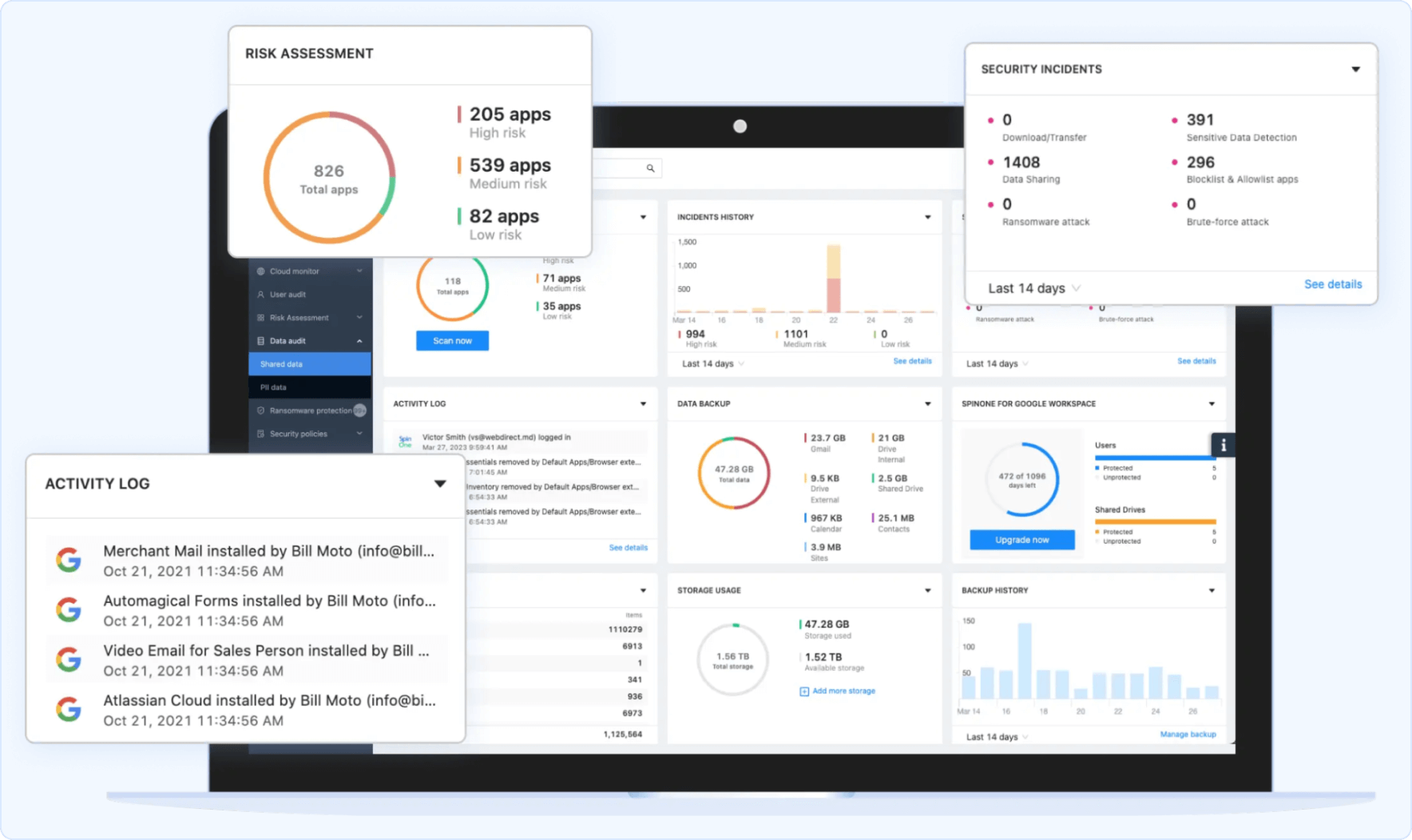
An example of a SaaS apps management tool for Google Workspace.
Summing up, we’ll see more marketing teams making a thorough audit of their Marketing Technology stack and discontinuing certain tools that haven’t proven to be useful.
We also think that along with mutual integration of marketing solutions, we’ll see the adoption of one tool to rule them all. It might be AI-based MarTech solutions which consumes and analyzes large data sets from other tools. It could be something more sophisticated like omnichannel solutions that not only analyze but also help manage the processes.
Gamification in Digital Marketing
Marketing gamification has been around for over a century now. Yet, with the new IT capabilities and the current state of customer engagement, it is becoming one of the leading Marketing Technology Trends. Smartly utilizing the psychology of gaming, brands can create customer journeys that naturally attract attention, amuse and efficiently battle outside distraction, leaving a long-lasting impression on clients.
The best thing is that companies don’t need significant budget or time investment as Marketing Technology platforms offer market-ready branded games. As a result, a gamification campaign can be configured and launched faster than planned and approved.
Optimizing Your Business with the Right MarTech Stack
When managed properly, MarTech tools can help you achieve your marketing goals and save costs by making informed decisions on your next campaign. Modern market has been growing exponentially and offers today over 14K Marketing Technology solutions covering many marketing activities.
In the future, we’ll see more tools with integrated AI capabilities, more platforms that unify siloed solutions into one ecosystem, and more capabilities in customer engagement driven by gamification.
Rate this article
FAQ
Discover How the Right MarTech Stack Improve Marketing Performance
Learn how gamification and smart MarTech tools improve campaigns. Book a personalized demo to see how your marketing can achieve better results.
Book demoKeep Learning
The Psychology Behind Gamification for Successful Marketing Strategies
How does gamification in marketing work? Dive deep in gaming psychology, understand the drives that make us enjoy games, and learn how you can harness gamification for your next marketing campaign.

Custom Marketing Game Development vs Using Winday: Budget and Timeframes
Are you interested to know how marketing games are made and what’s the best way to build your very own game? Check out our guide for insights on game dev roadmap, prices & timeframe.
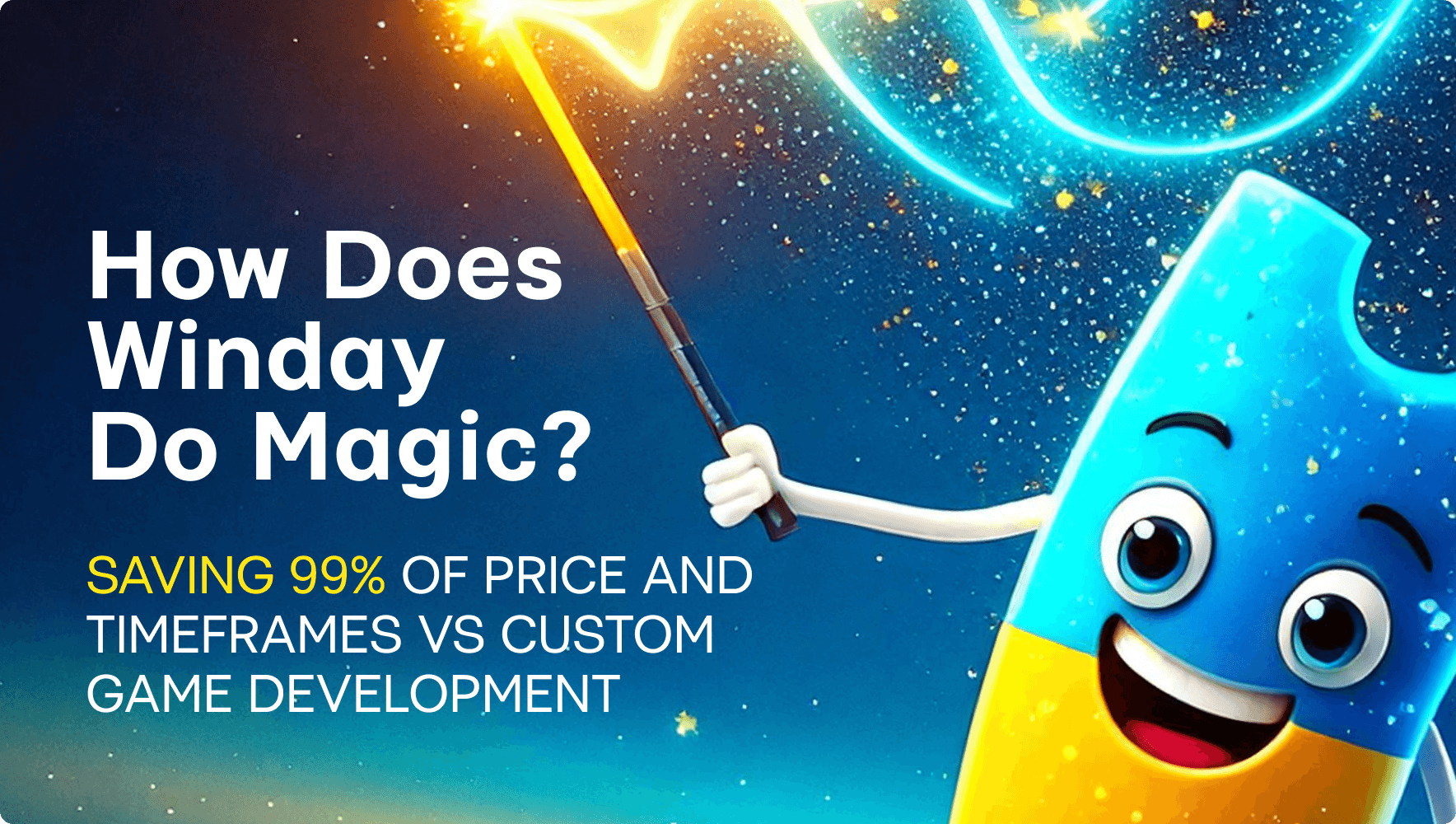
What is Brand Engagement and how to increase it with Gamification
What is brand engagement, and what is the role of gamification in it? In a this article, we explore brand engagement and how gamified elements can improve it in your business.
